Innovation and Commercialisation
VerifiedAdded on 2023/01/10
|18
|5030
|69
AI Summary
This document discusses the concept of innovation and its importance for business organisations. It compares innovation with invention and explores the factors influencing and shaping innovation and commercialisation. It also delves into the 4Ps of innovation and the significance of the innovation funnel. Additionally, it discusses the development and growth of frugal innovation.
Contribute Materials
Your contribution can guide someone’s learning journey. Share your
documents today.
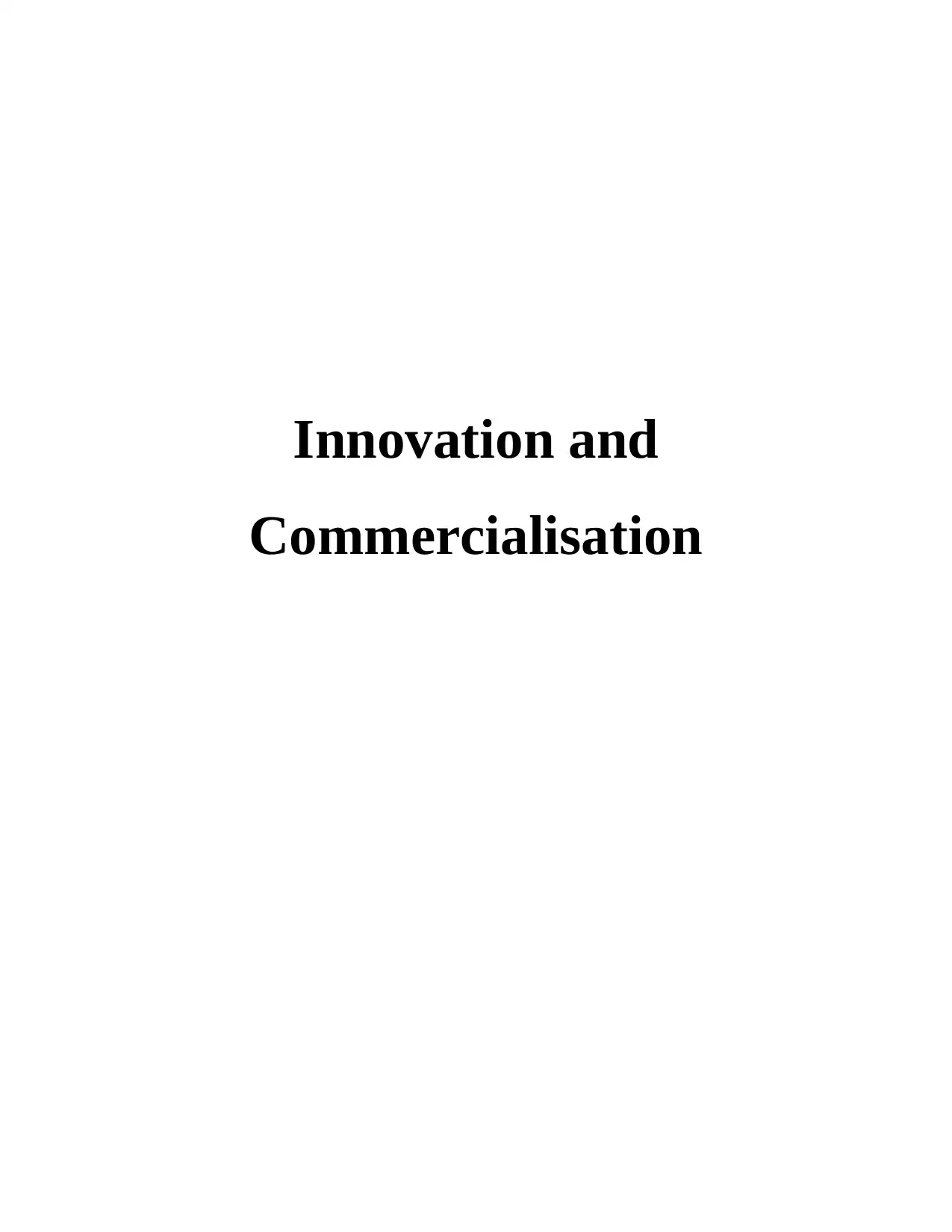
Innovation and
Commercialisation
Commercialisation
Secure Best Marks with AI Grader
Need help grading? Try our AI Grader for instant feedback on your assignments.
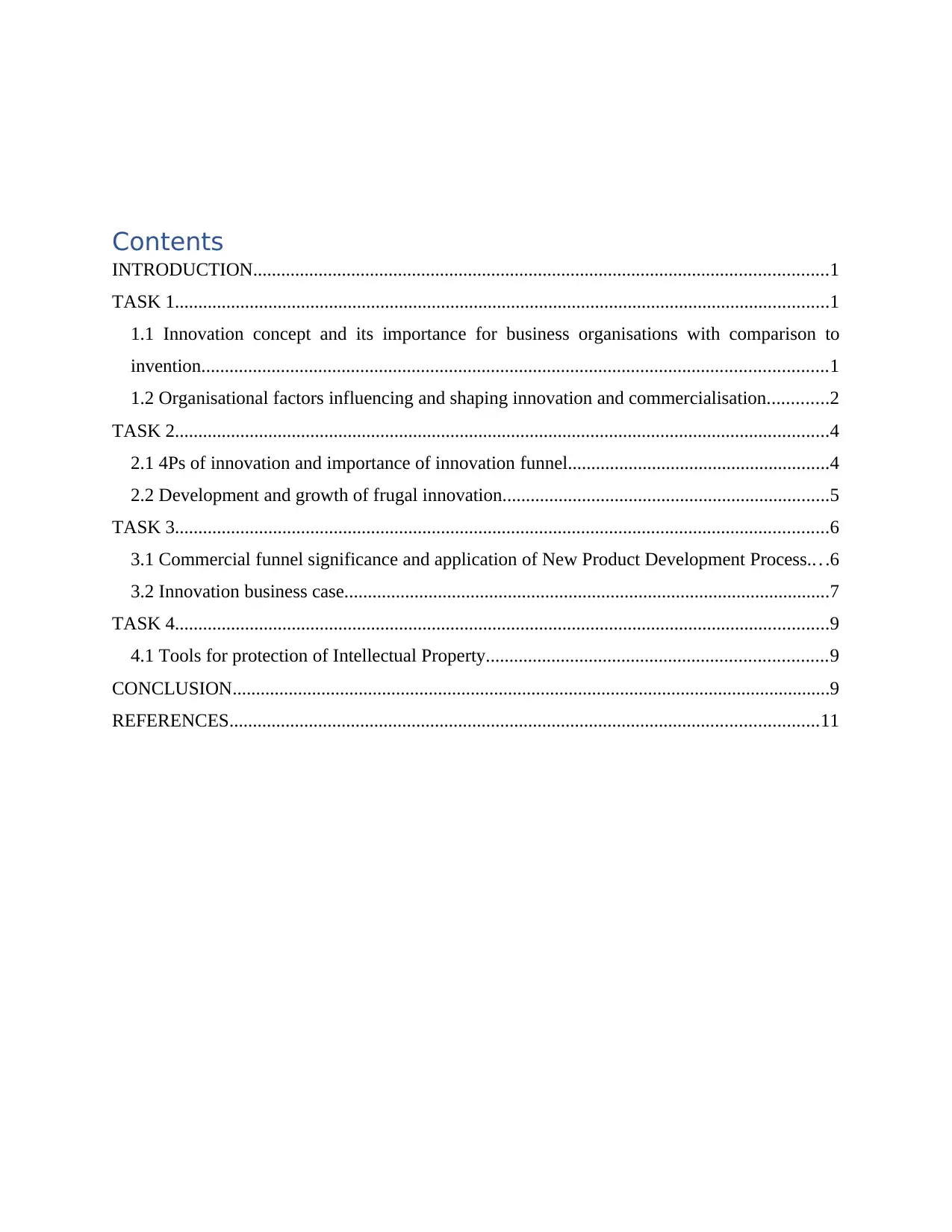
Contents
INTRODUCTION...........................................................................................................................1
TASK 1............................................................................................................................................1
1.1 Innovation concept and its importance for business organisations with comparison to
invention......................................................................................................................................1
1.2 Organisational factors influencing and shaping innovation and commercialisation.............2
TASK 2............................................................................................................................................4
2.1 4Ps of innovation and importance of innovation funnel........................................................4
2.2 Development and growth of frugal innovation......................................................................5
TASK 3............................................................................................................................................6
3.1 Commercial funnel significance and application of New Product Development Process.. . .6
3.2 Innovation business case........................................................................................................7
TASK 4............................................................................................................................................9
4.1 Tools for protection of Intellectual Property.........................................................................9
CONCLUSION................................................................................................................................9
REFERENCES..............................................................................................................................11
INTRODUCTION...........................................................................................................................1
TASK 1............................................................................................................................................1
1.1 Innovation concept and its importance for business organisations with comparison to
invention......................................................................................................................................1
1.2 Organisational factors influencing and shaping innovation and commercialisation.............2
TASK 2............................................................................................................................................4
2.1 4Ps of innovation and importance of innovation funnel........................................................4
2.2 Development and growth of frugal innovation......................................................................5
TASK 3............................................................................................................................................6
3.1 Commercial funnel significance and application of New Product Development Process.. . .6
3.2 Innovation business case........................................................................................................7
TASK 4............................................................................................................................................9
4.1 Tools for protection of Intellectual Property.........................................................................9
CONCLUSION................................................................................................................................9
REFERENCES..............................................................................................................................11
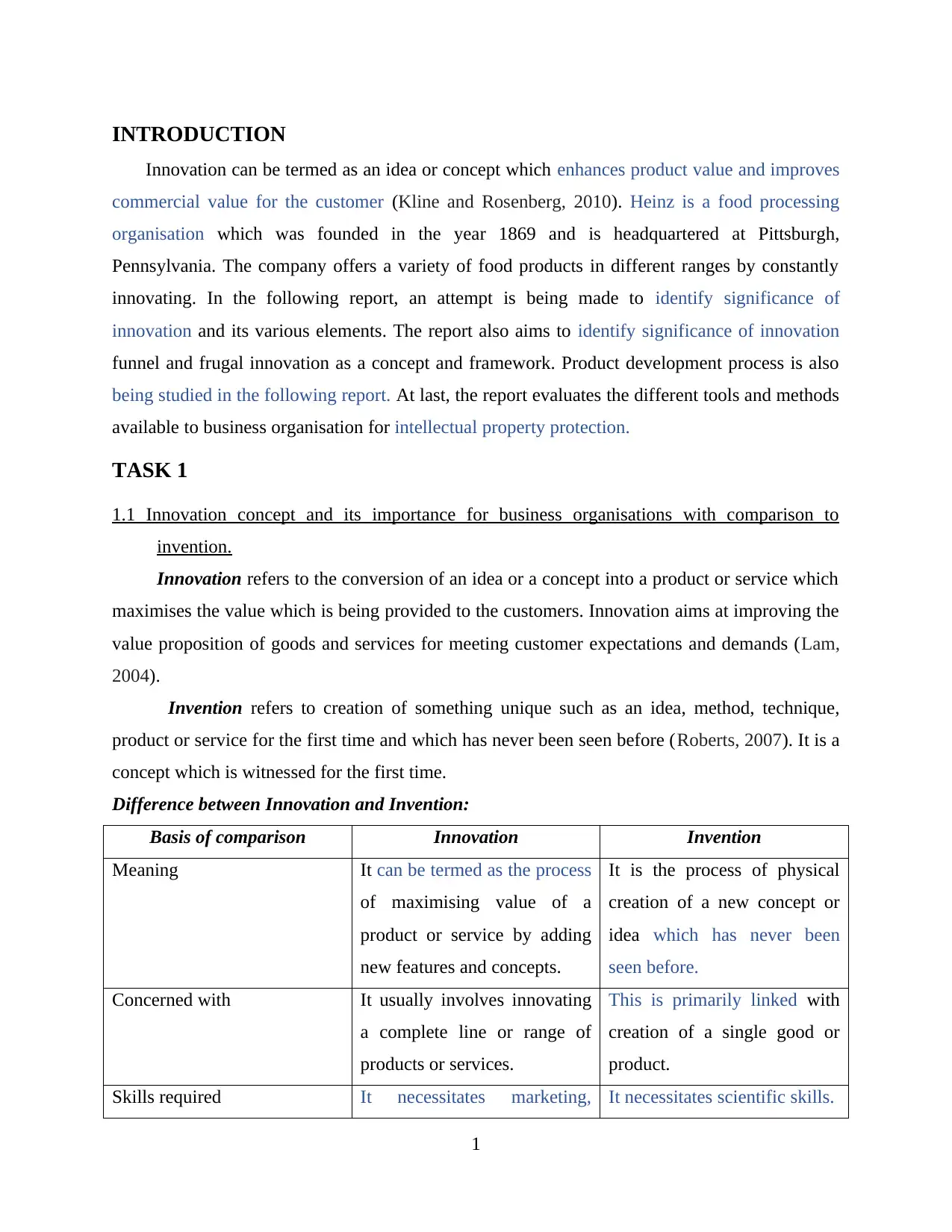
INTRODUCTION
Innovation can be termed as an idea or concept which enhances product value and improves
commercial value for the customer (Kline and Rosenberg, 2010). Heinz is a food processing
organisation which was founded in the year 1869 and is headquartered at Pittsburgh,
Pennsylvania. The company offers a variety of food products in different ranges by constantly
innovating. In the following report, an attempt is being made to identify significance of
innovation and its various elements. The report also aims to identify significance of innovation
funnel and frugal innovation as a concept and framework. Product development process is also
being studied in the following report. At last, the report evaluates the different tools and methods
available to business organisation for intellectual property protection.
TASK 1
1.1 Innovation concept and its importance for business organisations with comparison to
invention.
Innovation refers to the conversion of an idea or a concept into a product or service which
maximises the value which is being provided to the customers. Innovation aims at improving the
value proposition of goods and services for meeting customer expectations and demands (Lam,
2004).
Invention refers to creation of something unique such as an idea, method, technique,
product or service for the first time and which has never been seen before (Roberts, 2007). It is a
concept which is witnessed for the first time.
Difference between Innovation and Invention:
Basis of comparison Innovation Invention
Meaning It can be termed as the process
of maximising value of a
product or service by adding
new features and concepts.
It is the process of physical
creation of a new concept or
idea which has never been
seen before.
Concerned with It usually involves innovating
a complete line or range of
products or services.
This is primarily linked with
creation of a single good or
product.
Skills required It necessitates marketing, It necessitates scientific skills.
1
Innovation can be termed as an idea or concept which enhances product value and improves
commercial value for the customer (Kline and Rosenberg, 2010). Heinz is a food processing
organisation which was founded in the year 1869 and is headquartered at Pittsburgh,
Pennsylvania. The company offers a variety of food products in different ranges by constantly
innovating. In the following report, an attempt is being made to identify significance of
innovation and its various elements. The report also aims to identify significance of innovation
funnel and frugal innovation as a concept and framework. Product development process is also
being studied in the following report. At last, the report evaluates the different tools and methods
available to business organisation for intellectual property protection.
TASK 1
1.1 Innovation concept and its importance for business organisations with comparison to
invention.
Innovation refers to the conversion of an idea or a concept into a product or service which
maximises the value which is being provided to the customers. Innovation aims at improving the
value proposition of goods and services for meeting customer expectations and demands (Lam,
2004).
Invention refers to creation of something unique such as an idea, method, technique,
product or service for the first time and which has never been seen before (Roberts, 2007). It is a
concept which is witnessed for the first time.
Difference between Innovation and Invention:
Basis of comparison Innovation Invention
Meaning It can be termed as the process
of maximising value of a
product or service by adding
new features and concepts.
It is the process of physical
creation of a new concept or
idea which has never been
seen before.
Concerned with It usually involves innovating
a complete line or range of
products or services.
This is primarily linked with
creation of a single good or
product.
Skills required It necessitates marketing, It necessitates scientific skills.
1
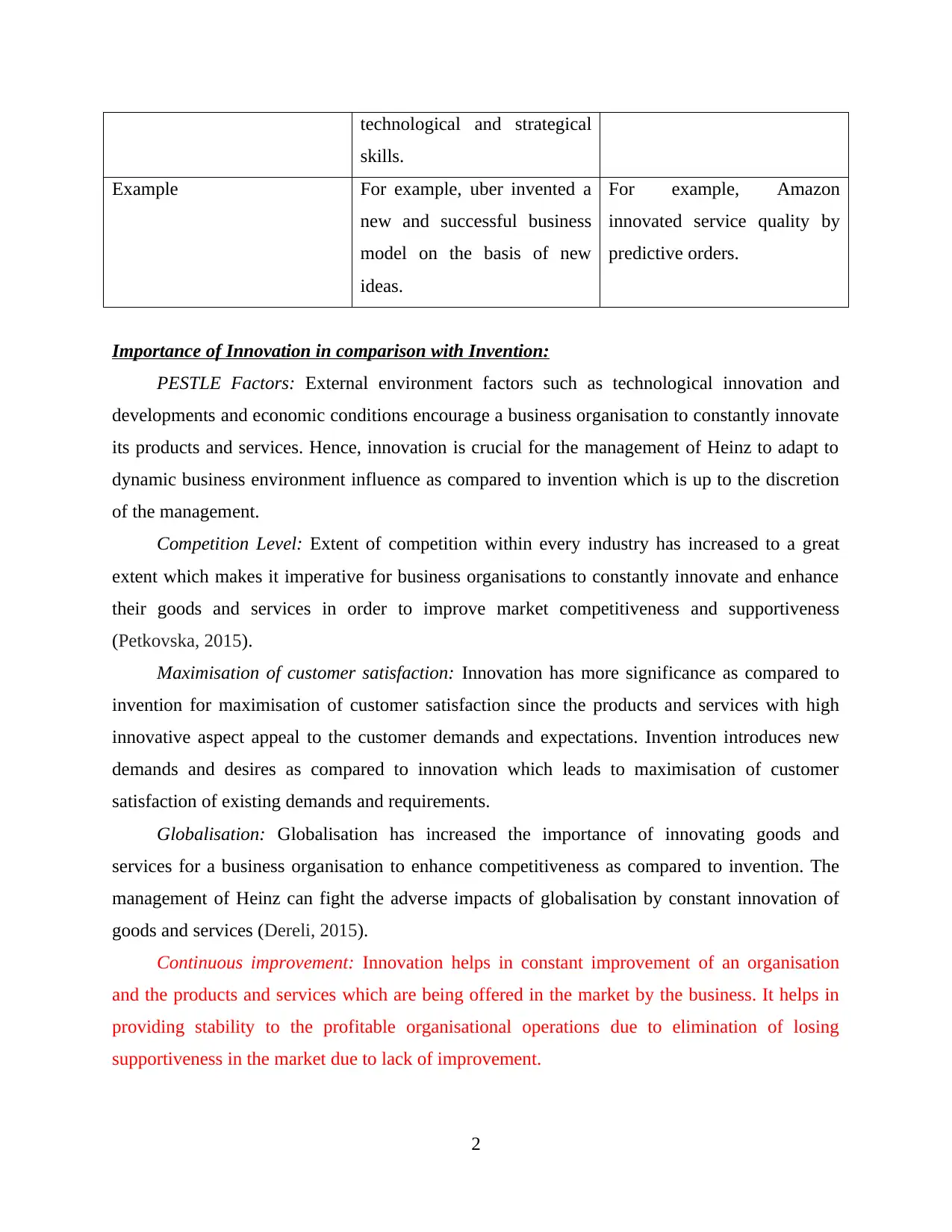
technological and strategical
skills.
Example For example, uber invented a
new and successful business
model on the basis of new
ideas.
For example, Amazon
innovated service quality by
predictive orders.
Importance of Innovation in comparison with Invention:
PESTLE Factors: External environment factors such as technological innovation and
developments and economic conditions encourage a business organisation to constantly innovate
its products and services. Hence, innovation is crucial for the management of Heinz to adapt to
dynamic business environment influence as compared to invention which is up to the discretion
of the management.
Competition Level: Extent of competition within every industry has increased to a great
extent which makes it imperative for business organisations to constantly innovate and enhance
their goods and services in order to improve market competitiveness and supportiveness
(Petkovska, 2015).
Maximisation of customer satisfaction: Innovation has more significance as compared to
invention for maximisation of customer satisfaction since the products and services with high
innovative aspect appeal to the customer demands and expectations. Invention introduces new
demands and desires as compared to innovation which leads to maximisation of customer
satisfaction of existing demands and requirements.
Globalisation: Globalisation has increased the importance of innovating goods and
services for a business organisation to enhance competitiveness as compared to invention. The
management of Heinz can fight the adverse impacts of globalisation by constant innovation of
goods and services (Dereli, 2015).
Continuous improvement: Innovation helps in constant improvement of an organisation
and the products and services which are being offered in the market by the business. It helps in
providing stability to the profitable organisational operations due to elimination of losing
supportiveness in the market due to lack of improvement.
2
skills.
Example For example, uber invented a
new and successful business
model on the basis of new
ideas.
For example, Amazon
innovated service quality by
predictive orders.
Importance of Innovation in comparison with Invention:
PESTLE Factors: External environment factors such as technological innovation and
developments and economic conditions encourage a business organisation to constantly innovate
its products and services. Hence, innovation is crucial for the management of Heinz to adapt to
dynamic business environment influence as compared to invention which is up to the discretion
of the management.
Competition Level: Extent of competition within every industry has increased to a great
extent which makes it imperative for business organisations to constantly innovate and enhance
their goods and services in order to improve market competitiveness and supportiveness
(Petkovska, 2015).
Maximisation of customer satisfaction: Innovation has more significance as compared to
invention for maximisation of customer satisfaction since the products and services with high
innovative aspect appeal to the customer demands and expectations. Invention introduces new
demands and desires as compared to innovation which leads to maximisation of customer
satisfaction of existing demands and requirements.
Globalisation: Globalisation has increased the importance of innovating goods and
services for a business organisation to enhance competitiveness as compared to invention. The
management of Heinz can fight the adverse impacts of globalisation by constant innovation of
goods and services (Dereli, 2015).
Continuous improvement: Innovation helps in constant improvement of an organisation
and the products and services which are being offered in the market by the business. It helps in
providing stability to the profitable organisational operations due to elimination of losing
supportiveness in the market due to lack of improvement.
2
Secure Best Marks with AI Grader
Need help grading? Try our AI Grader for instant feedback on your assignments.
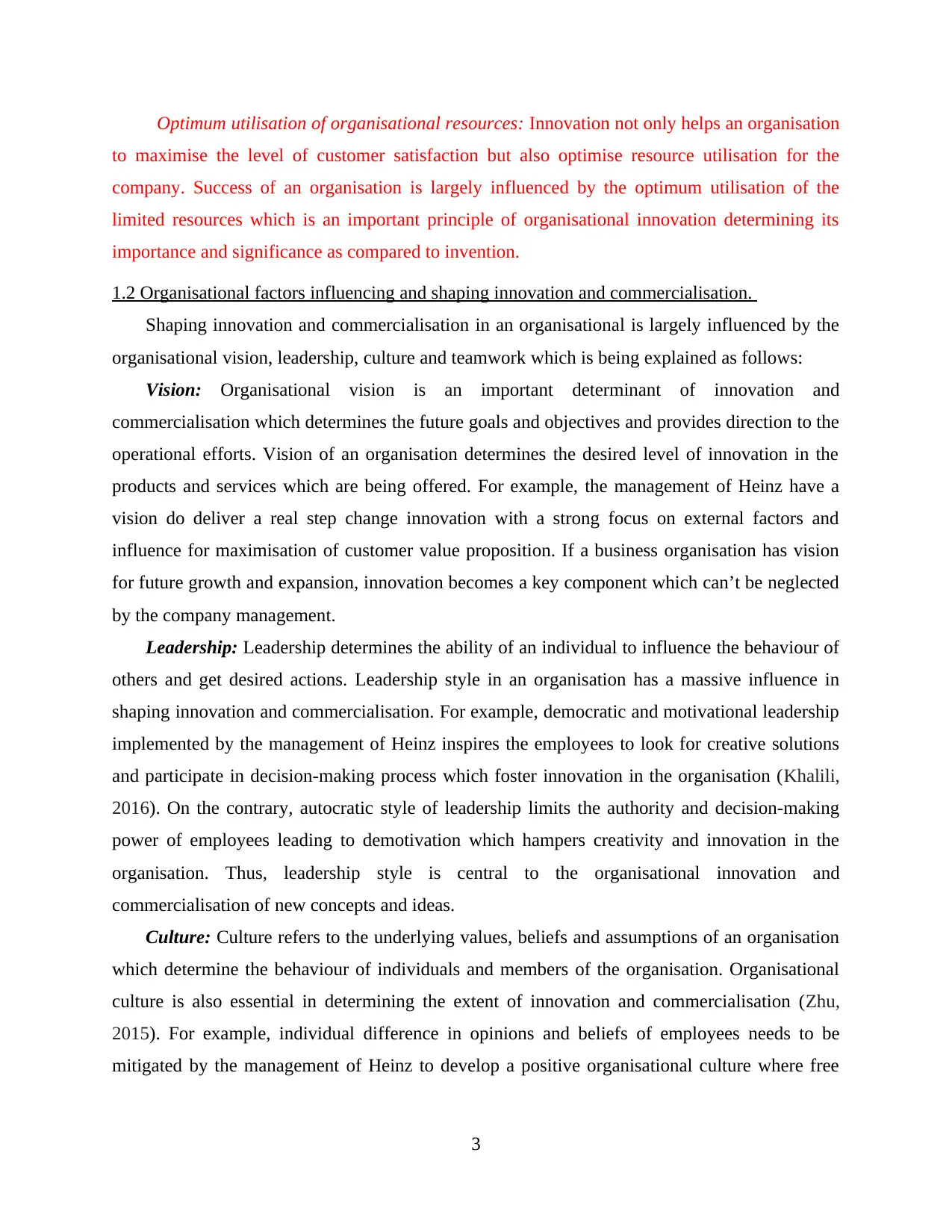
Optimum utilisation of organisational resources: Innovation not only helps an organisation
to maximise the level of customer satisfaction but also optimise resource utilisation for the
company. Success of an organisation is largely influenced by the optimum utilisation of the
limited resources which is an important principle of organisational innovation determining its
importance and significance as compared to invention.
1.2 Organisational factors influencing and shaping innovation and commercialisation.
Shaping innovation and commercialisation in an organisational is largely influenced by the
organisational vision, leadership, culture and teamwork which is being explained as follows:
Vision: Organisational vision is an important determinant of innovation and
commercialisation which determines the future goals and objectives and provides direction to the
operational efforts. Vision of an organisation determines the desired level of innovation in the
products and services which are being offered. For example, the management of Heinz have a
vision do deliver a real step change innovation with a strong focus on external factors and
influence for maximisation of customer value proposition. If a business organisation has vision
for future growth and expansion, innovation becomes a key component which can’t be neglected
by the company management.
Leadership: Leadership determines the ability of an individual to influence the behaviour of
others and get desired actions. Leadership style in an organisation has a massive influence in
shaping innovation and commercialisation. For example, democratic and motivational leadership
implemented by the management of Heinz inspires the employees to look for creative solutions
and participate in decision-making process which foster innovation in the organisation (Khalili,
2016). On the contrary, autocratic style of leadership limits the authority and decision-making
power of employees leading to demotivation which hampers creativity and innovation in the
organisation. Thus, leadership style is central to the organisational innovation and
commercialisation of new concepts and ideas.
Culture: Culture refers to the underlying values, beliefs and assumptions of an organisation
which determine the behaviour of individuals and members of the organisation. Organisational
culture is also essential in determining the extent of innovation and commercialisation (Zhu,
2015). For example, individual difference in opinions and beliefs of employees needs to be
mitigated by the management of Heinz to develop a positive organisational culture where free
3
to maximise the level of customer satisfaction but also optimise resource utilisation for the
company. Success of an organisation is largely influenced by the optimum utilisation of the
limited resources which is an important principle of organisational innovation determining its
importance and significance as compared to invention.
1.2 Organisational factors influencing and shaping innovation and commercialisation.
Shaping innovation and commercialisation in an organisational is largely influenced by the
organisational vision, leadership, culture and teamwork which is being explained as follows:
Vision: Organisational vision is an important determinant of innovation and
commercialisation which determines the future goals and objectives and provides direction to the
operational efforts. Vision of an organisation determines the desired level of innovation in the
products and services which are being offered. For example, the management of Heinz have a
vision do deliver a real step change innovation with a strong focus on external factors and
influence for maximisation of customer value proposition. If a business organisation has vision
for future growth and expansion, innovation becomes a key component which can’t be neglected
by the company management.
Leadership: Leadership determines the ability of an individual to influence the behaviour of
others and get desired actions. Leadership style in an organisation has a massive influence in
shaping innovation and commercialisation. For example, democratic and motivational leadership
implemented by the management of Heinz inspires the employees to look for creative solutions
and participate in decision-making process which foster innovation in the organisation (Khalili,
2016). On the contrary, autocratic style of leadership limits the authority and decision-making
power of employees leading to demotivation which hampers creativity and innovation in the
organisation. Thus, leadership style is central to the organisational innovation and
commercialisation of new concepts and ideas.
Culture: Culture refers to the underlying values, beliefs and assumptions of an organisation
which determine the behaviour of individuals and members of the organisation. Organisational
culture is also essential in determining the extent of innovation and commercialisation (Zhu,
2015). For example, individual difference in opinions and beliefs of employees needs to be
mitigated by the management of Heinz to develop a positive organisational culture where free
3
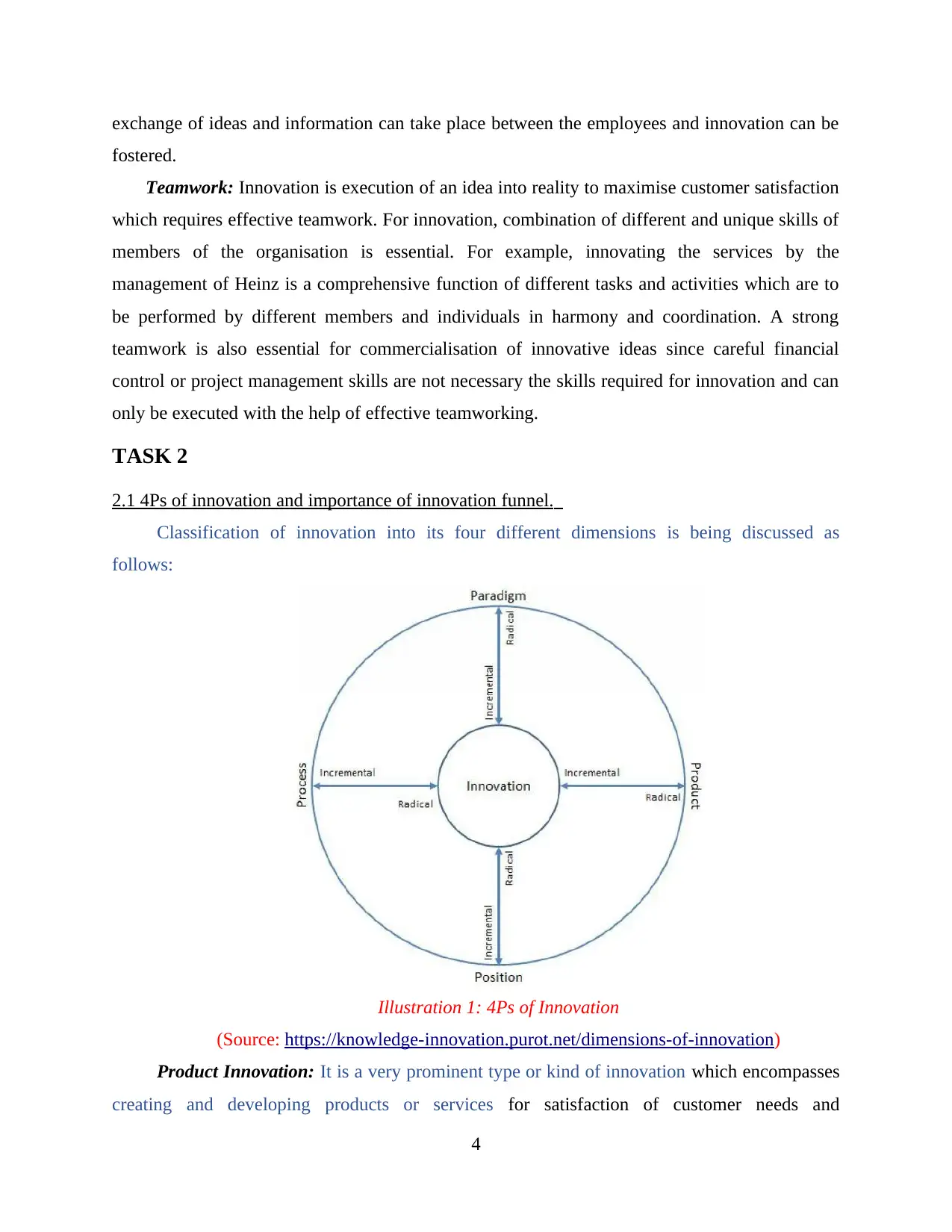
exchange of ideas and information can take place between the employees and innovation can be
fostered.
Teamwork: Innovation is execution of an idea into reality to maximise customer satisfaction
which requires effective teamwork. For innovation, combination of different and unique skills of
members of the organisation is essential. For example, innovating the services by the
management of Heinz is a comprehensive function of different tasks and activities which are to
be performed by different members and individuals in harmony and coordination. A strong
teamwork is also essential for commercialisation of innovative ideas since careful financial
control or project management skills are not necessary the skills required for innovation and can
only be executed with the help of effective teamworking.
TASK 2
2.1 4Ps of innovation and importance of innovation funnel.
Classification of innovation into its four different dimensions is being discussed as
follows:
Illustration 1: 4Ps of Innovation
(Source: https://knowledge-innovation.purot.net/dimensions-of-innovation)
Product Innovation: It is a very prominent type or kind of innovation which encompasses
creating and developing products or services for satisfaction of customer needs and
4
fostered.
Teamwork: Innovation is execution of an idea into reality to maximise customer satisfaction
which requires effective teamwork. For innovation, combination of different and unique skills of
members of the organisation is essential. For example, innovating the services by the
management of Heinz is a comprehensive function of different tasks and activities which are to
be performed by different members and individuals in harmony and coordination. A strong
teamwork is also essential for commercialisation of innovative ideas since careful financial
control or project management skills are not necessary the skills required for innovation and can
only be executed with the help of effective teamworking.
TASK 2
2.1 4Ps of innovation and importance of innovation funnel.
Classification of innovation into its four different dimensions is being discussed as
follows:
Illustration 1: 4Ps of Innovation
(Source: https://knowledge-innovation.purot.net/dimensions-of-innovation)
Product Innovation: It is a very prominent type or kind of innovation which encompasses
creating and developing products or services for satisfaction of customer needs and
4
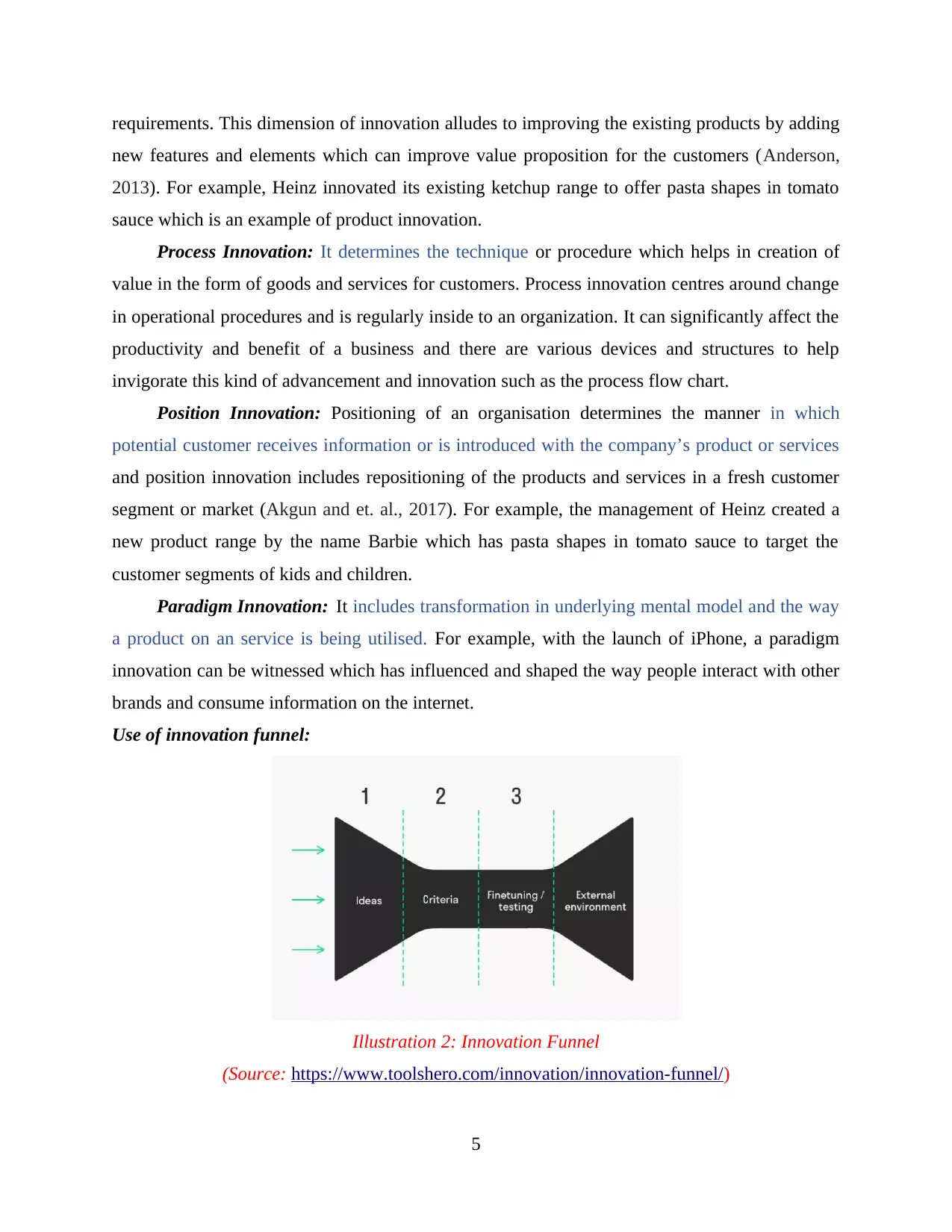
requirements. This dimension of innovation alludes to improving the existing products by adding
new features and elements which can improve value proposition for the customers (Anderson,
2013). For example, Heinz innovated its existing ketchup range to offer pasta shapes in tomato
sauce which is an example of product innovation.
Process Innovation: It determines the technique or procedure which helps in creation of
value in the form of goods and services for customers. Process innovation centres around change
in operational procedures and is regularly inside to an organization. It can significantly affect the
productivity and benefit of a business and there are various devices and structures to help
invigorate this kind of advancement and innovation such as the process flow chart.
Position Innovation: Positioning of an organisation determines the manner in which
potential customer receives information or is introduced with the company’s product or services
and position innovation includes repositioning of the products and services in a fresh customer
segment or market (Akgun and et. al., 2017). For example, the management of Heinz created a
new product range by the name Barbie which has pasta shapes in tomato sauce to target the
customer segments of kids and children.
Paradigm Innovation: It includes transformation in underlying mental model and the way
a product on an service is being utilised. For example, with the launch of iPhone, a paradigm
innovation can be witnessed which has influenced and shaped the way people interact with other
brands and consume information on the internet.
Use of innovation funnel:
Illustration 2: Innovation Funnel
(Source: https://www.toolshero.com/innovation/innovation-funnel/)
5
new features and elements which can improve value proposition for the customers (Anderson,
2013). For example, Heinz innovated its existing ketchup range to offer pasta shapes in tomato
sauce which is an example of product innovation.
Process Innovation: It determines the technique or procedure which helps in creation of
value in the form of goods and services for customers. Process innovation centres around change
in operational procedures and is regularly inside to an organization. It can significantly affect the
productivity and benefit of a business and there are various devices and structures to help
invigorate this kind of advancement and innovation such as the process flow chart.
Position Innovation: Positioning of an organisation determines the manner in which
potential customer receives information or is introduced with the company’s product or services
and position innovation includes repositioning of the products and services in a fresh customer
segment or market (Akgun and et. al., 2017). For example, the management of Heinz created a
new product range by the name Barbie which has pasta shapes in tomato sauce to target the
customer segments of kids and children.
Paradigm Innovation: It includes transformation in underlying mental model and the way
a product on an service is being utilised. For example, with the launch of iPhone, a paradigm
innovation can be witnessed which has influenced and shaped the way people interact with other
brands and consume information on the internet.
Use of innovation funnel:
Illustration 2: Innovation Funnel
(Source: https://www.toolshero.com/innovation/innovation-funnel/)
5
Paraphrase This Document
Need a fresh take? Get an instant paraphrase of this document with our AI Paraphraser
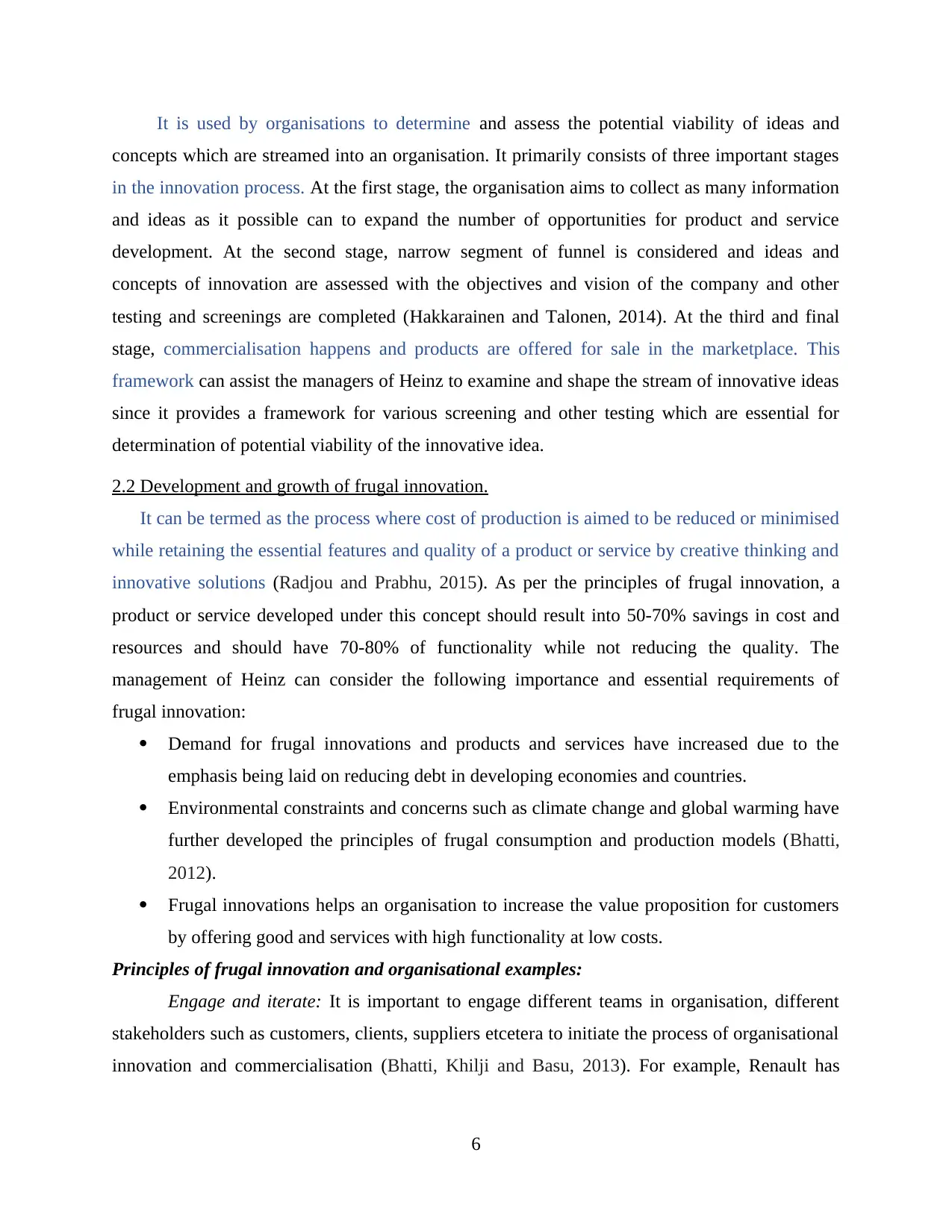
It is used by organisations to determine and assess the potential viability of ideas and
concepts which are streamed into an organisation. It primarily consists of three important stages
in the innovation process. At the first stage, the organisation aims to collect as many information
and ideas as it possible can to expand the number of opportunities for product and service
development. At the second stage, narrow segment of funnel is considered and ideas and
concepts of innovation are assessed with the objectives and vision of the company and other
testing and screenings are completed (Hakkarainen and Talonen, 2014). At the third and final
stage, commercialisation happens and products are offered for sale in the marketplace. This
framework can assist the managers of Heinz to examine and shape the stream of innovative ideas
since it provides a framework for various screening and other testing which are essential for
determination of potential viability of the innovative idea.
2.2 Development and growth of frugal innovation.
It can be termed as the process where cost of production is aimed to be reduced or minimised
while retaining the essential features and quality of a product or service by creative thinking and
innovative solutions (Radjou and Prabhu, 2015). As per the principles of frugal innovation, a
product or service developed under this concept should result into 50-70% savings in cost and
resources and should have 70-80% of functionality while not reducing the quality. The
management of Heinz can consider the following importance and essential requirements of
frugal innovation:
Demand for frugal innovations and products and services have increased due to the
emphasis being laid on reducing debt in developing economies and countries.
Environmental constraints and concerns such as climate change and global warming have
further developed the principles of frugal consumption and production models (Bhatti,
2012).
Frugal innovations helps an organisation to increase the value proposition for customers
by offering good and services with high functionality at low costs.
Principles of frugal innovation and organisational examples:
Engage and iterate: It is important to engage different teams in organisation, different
stakeholders such as customers, clients, suppliers etcetera to initiate the process of organisational
innovation and commercialisation (Bhatti, Khilji and Basu, 2013). For example, Renault has
6
concepts which are streamed into an organisation. It primarily consists of three important stages
in the innovation process. At the first stage, the organisation aims to collect as many information
and ideas as it possible can to expand the number of opportunities for product and service
development. At the second stage, narrow segment of funnel is considered and ideas and
concepts of innovation are assessed with the objectives and vision of the company and other
testing and screenings are completed (Hakkarainen and Talonen, 2014). At the third and final
stage, commercialisation happens and products are offered for sale in the marketplace. This
framework can assist the managers of Heinz to examine and shape the stream of innovative ideas
since it provides a framework for various screening and other testing which are essential for
determination of potential viability of the innovative idea.
2.2 Development and growth of frugal innovation.
It can be termed as the process where cost of production is aimed to be reduced or minimised
while retaining the essential features and quality of a product or service by creative thinking and
innovative solutions (Radjou and Prabhu, 2015). As per the principles of frugal innovation, a
product or service developed under this concept should result into 50-70% savings in cost and
resources and should have 70-80% of functionality while not reducing the quality. The
management of Heinz can consider the following importance and essential requirements of
frugal innovation:
Demand for frugal innovations and products and services have increased due to the
emphasis being laid on reducing debt in developing economies and countries.
Environmental constraints and concerns such as climate change and global warming have
further developed the principles of frugal consumption and production models (Bhatti,
2012).
Frugal innovations helps an organisation to increase the value proposition for customers
by offering good and services with high functionality at low costs.
Principles of frugal innovation and organisational examples:
Engage and iterate: It is important to engage different teams in organisation, different
stakeholders such as customers, clients, suppliers etcetera to initiate the process of organisational
innovation and commercialisation (Bhatti, Khilji and Basu, 2013). For example, Renault has
6
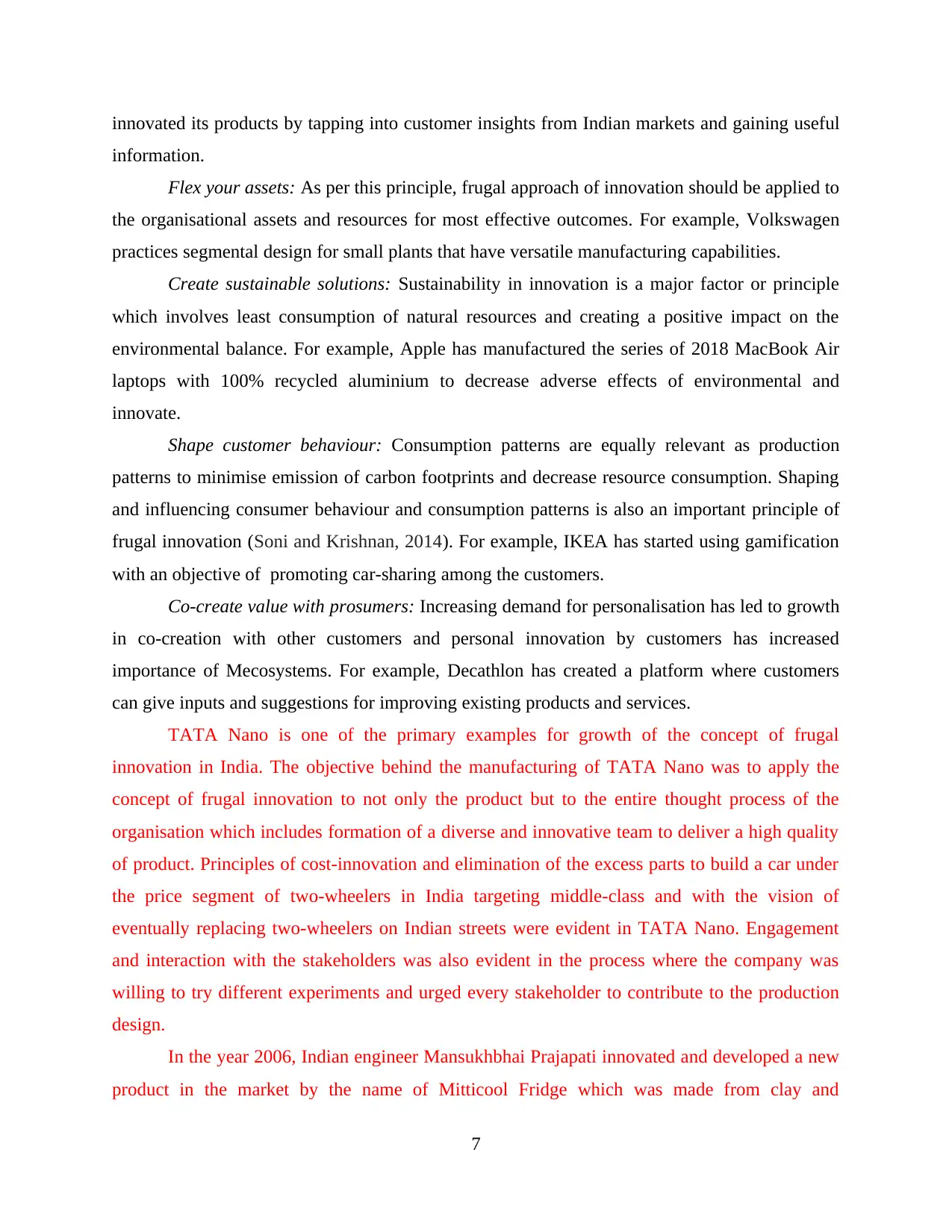
innovated its products by tapping into customer insights from Indian markets and gaining useful
information.
Flex your assets: As per this principle, frugal approach of innovation should be applied to
the organisational assets and resources for most effective outcomes. For example, Volkswagen
practices segmental design for small plants that have versatile manufacturing capabilities.
Create sustainable solutions: Sustainability in innovation is a major factor or principle
which involves least consumption of natural resources and creating a positive impact on the
environmental balance. For example, Apple has manufactured the series of 2018 MacBook Air
laptops with 100% recycled aluminium to decrease adverse effects of environmental and
innovate.
Shape customer behaviour: Consumption patterns are equally relevant as production
patterns to minimise emission of carbon footprints and decrease resource consumption. Shaping
and influencing consumer behaviour and consumption patterns is also an important principle of
frugal innovation (Soni and Krishnan, 2014). For example, IKEA has started using gamification
with an objective of promoting car-sharing among the customers.
Co-create value with prosumers: Increasing demand for personalisation has led to growth
in co-creation with other customers and personal innovation by customers has increased
importance of Mecosystems. For example, Decathlon has created a platform where customers
can give inputs and suggestions for improving existing products and services.
TATA Nano is one of the primary examples for growth of the concept of frugal
innovation in India. The objective behind the manufacturing of TATA Nano was to apply the
concept of frugal innovation to not only the product but to the entire thought process of the
organisation which includes formation of a diverse and innovative team to deliver a high quality
of product. Principles of cost-innovation and elimination of the excess parts to build a car under
the price segment of two-wheelers in India targeting middle-class and with the vision of
eventually replacing two-wheelers on Indian streets were evident in TATA Nano. Engagement
and interaction with the stakeholders was also evident in the process where the company was
willing to try different experiments and urged every stakeholder to contribute to the production
design.
In the year 2006, Indian engineer Mansukhbhai Prajapati innovated and developed a new
product in the market by the name of Mitticool Fridge which was made from clay and
7
information.
Flex your assets: As per this principle, frugal approach of innovation should be applied to
the organisational assets and resources for most effective outcomes. For example, Volkswagen
practices segmental design for small plants that have versatile manufacturing capabilities.
Create sustainable solutions: Sustainability in innovation is a major factor or principle
which involves least consumption of natural resources and creating a positive impact on the
environmental balance. For example, Apple has manufactured the series of 2018 MacBook Air
laptops with 100% recycled aluminium to decrease adverse effects of environmental and
innovate.
Shape customer behaviour: Consumption patterns are equally relevant as production
patterns to minimise emission of carbon footprints and decrease resource consumption. Shaping
and influencing consumer behaviour and consumption patterns is also an important principle of
frugal innovation (Soni and Krishnan, 2014). For example, IKEA has started using gamification
with an objective of promoting car-sharing among the customers.
Co-create value with prosumers: Increasing demand for personalisation has led to growth
in co-creation with other customers and personal innovation by customers has increased
importance of Mecosystems. For example, Decathlon has created a platform where customers
can give inputs and suggestions for improving existing products and services.
TATA Nano is one of the primary examples for growth of the concept of frugal
innovation in India. The objective behind the manufacturing of TATA Nano was to apply the
concept of frugal innovation to not only the product but to the entire thought process of the
organisation which includes formation of a diverse and innovative team to deliver a high quality
of product. Principles of cost-innovation and elimination of the excess parts to build a car under
the price segment of two-wheelers in India targeting middle-class and with the vision of
eventually replacing two-wheelers on Indian streets were evident in TATA Nano. Engagement
and interaction with the stakeholders was also evident in the process where the company was
willing to try different experiments and urged every stakeholder to contribute to the production
design.
In the year 2006, Indian engineer Mansukhbhai Prajapati innovated and developed a new
product in the market by the name of Mitticool Fridge which was made from clay and
7
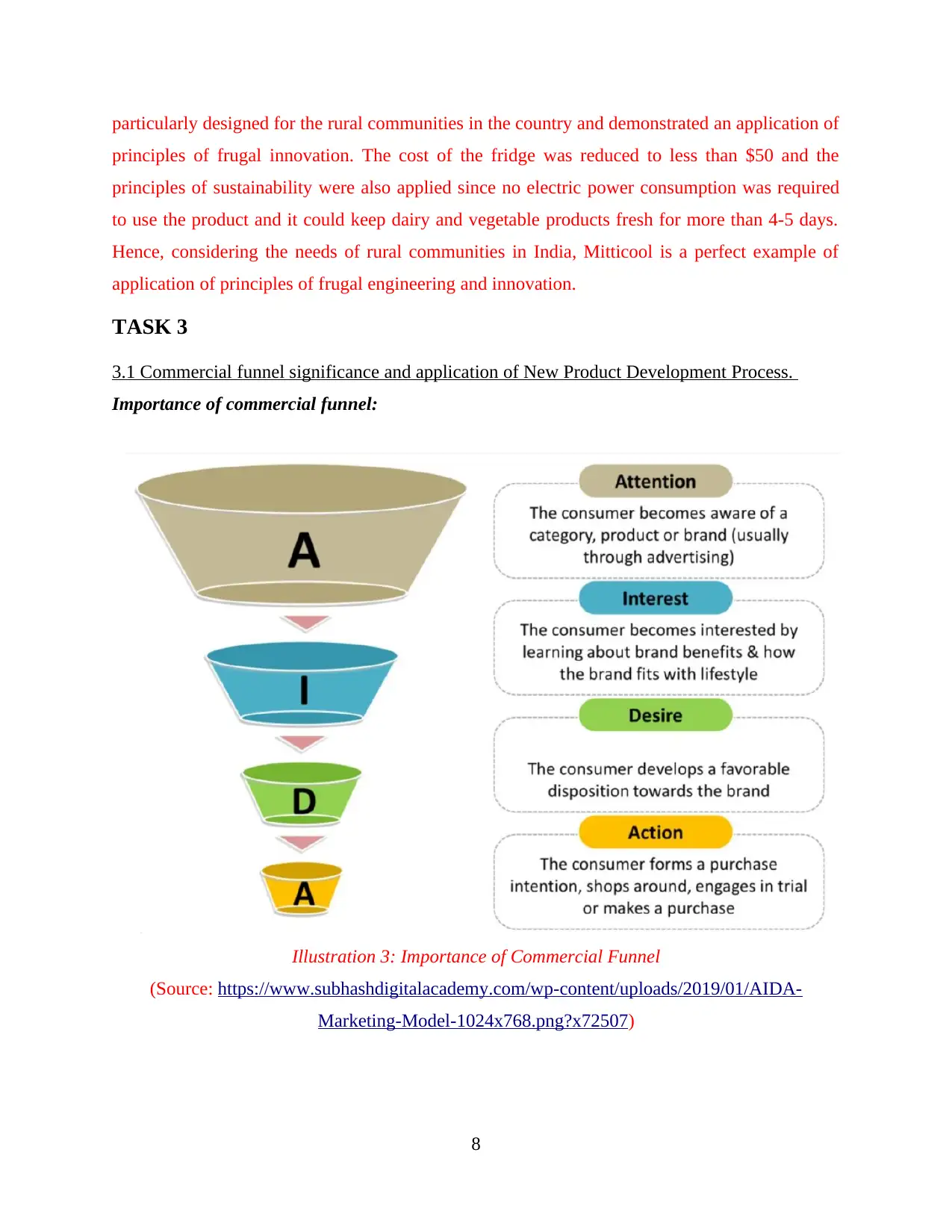
particularly designed for the rural communities in the country and demonstrated an application of
principles of frugal innovation. The cost of the fridge was reduced to less than $50 and the
principles of sustainability were also applied since no electric power consumption was required
to use the product and it could keep dairy and vegetable products fresh for more than 4-5 days.
Hence, considering the needs of rural communities in India, Mitticool is a perfect example of
application of principles of frugal engineering and innovation.
TASK 3
3.1 Commercial funnel significance and application of New Product Development Process.
Importance of commercial funnel:
Illustration 3: Importance of Commercial Funnel
(Source: https://www.subhashdigitalacademy.com/wp-content/uploads/2019/01/AIDA-
Marketing-Model-1024x768.png?x72507)
8
principles of frugal innovation. The cost of the fridge was reduced to less than $50 and the
principles of sustainability were also applied since no electric power consumption was required
to use the product and it could keep dairy and vegetable products fresh for more than 4-5 days.
Hence, considering the needs of rural communities in India, Mitticool is a perfect example of
application of principles of frugal engineering and innovation.
TASK 3
3.1 Commercial funnel significance and application of New Product Development Process.
Importance of commercial funnel:
Illustration 3: Importance of Commercial Funnel
(Source: https://www.subhashdigitalacademy.com/wp-content/uploads/2019/01/AIDA-
Marketing-Model-1024x768.png?x72507)
8
Secure Best Marks with AI Grader
Need help grading? Try our AI Grader for instant feedback on your assignments.
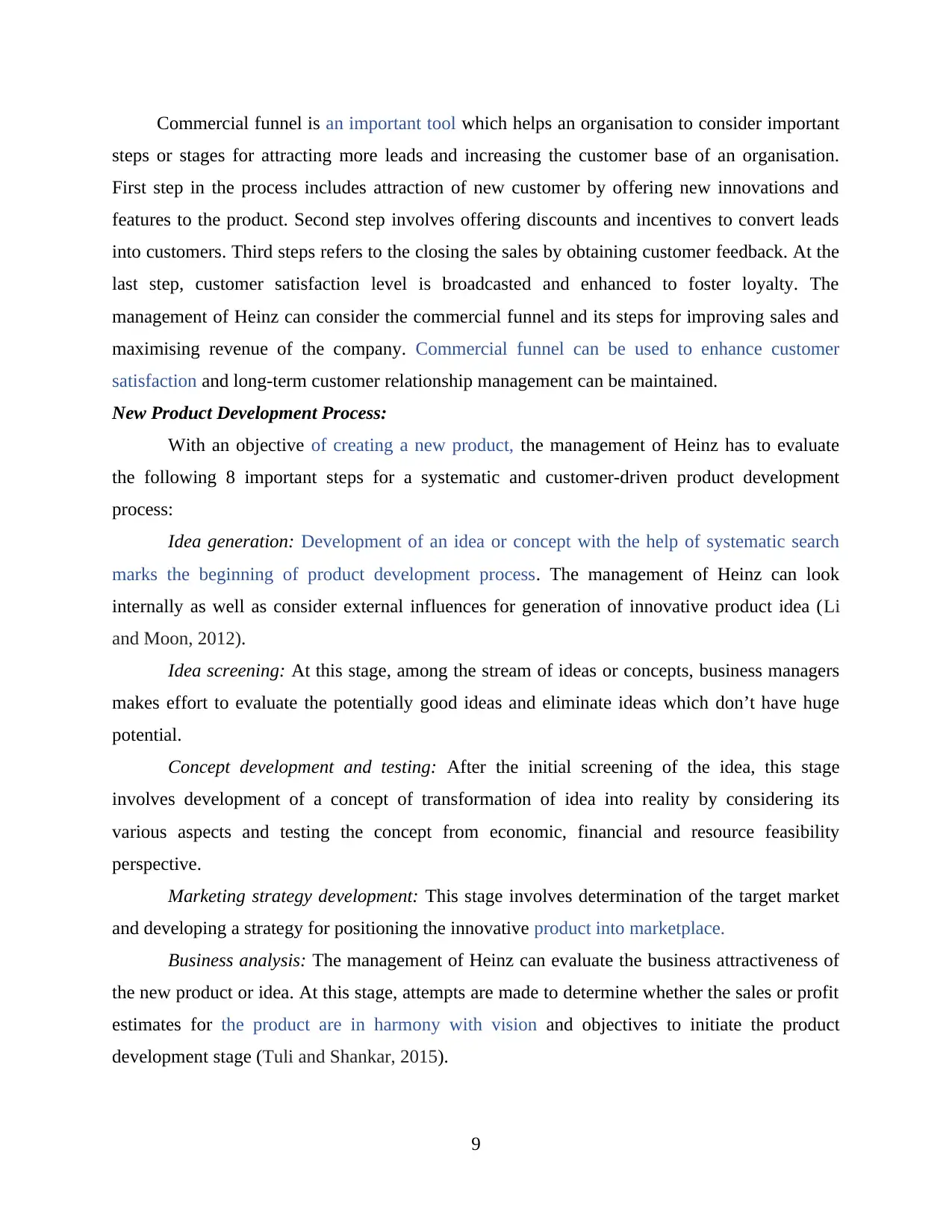
Commercial funnel is an important tool which helps an organisation to consider important
steps or stages for attracting more leads and increasing the customer base of an organisation.
First step in the process includes attraction of new customer by offering new innovations and
features to the product. Second step involves offering discounts and incentives to convert leads
into customers. Third steps refers to the closing the sales by obtaining customer feedback. At the
last step, customer satisfaction level is broadcasted and enhanced to foster loyalty. The
management of Heinz can consider the commercial funnel and its steps for improving sales and
maximising revenue of the company. Commercial funnel can be used to enhance customer
satisfaction and long-term customer relationship management can be maintained.
New Product Development Process:
With an objective of creating a new product, the management of Heinz has to evaluate
the following 8 important steps for a systematic and customer-driven product development
process:
Idea generation: Development of an idea or concept with the help of systematic search
marks the beginning of product development process. The management of Heinz can look
internally as well as consider external influences for generation of innovative product idea (Li
and Moon, 2012).
Idea screening: At this stage, among the stream of ideas or concepts, business managers
makes effort to evaluate the potentially good ideas and eliminate ideas which don’t have huge
potential.
Concept development and testing: After the initial screening of the idea, this stage
involves development of a concept of transformation of idea into reality by considering its
various aspects and testing the concept from economic, financial and resource feasibility
perspective.
Marketing strategy development: This stage involves determination of the target market
and developing a strategy for positioning the innovative product into marketplace.
Business analysis: The management of Heinz can evaluate the business attractiveness of
the new product or idea. At this stage, attempts are made to determine whether the sales or profit
estimates for the product are in harmony with vision and objectives to initiate the product
development stage (Tuli and Shankar, 2015).
9
steps or stages for attracting more leads and increasing the customer base of an organisation.
First step in the process includes attraction of new customer by offering new innovations and
features to the product. Second step involves offering discounts and incentives to convert leads
into customers. Third steps refers to the closing the sales by obtaining customer feedback. At the
last step, customer satisfaction level is broadcasted and enhanced to foster loyalty. The
management of Heinz can consider the commercial funnel and its steps for improving sales and
maximising revenue of the company. Commercial funnel can be used to enhance customer
satisfaction and long-term customer relationship management can be maintained.
New Product Development Process:
With an objective of creating a new product, the management of Heinz has to evaluate
the following 8 important steps for a systematic and customer-driven product development
process:
Idea generation: Development of an idea or concept with the help of systematic search
marks the beginning of product development process. The management of Heinz can look
internally as well as consider external influences for generation of innovative product idea (Li
and Moon, 2012).
Idea screening: At this stage, among the stream of ideas or concepts, business managers
makes effort to evaluate the potentially good ideas and eliminate ideas which don’t have huge
potential.
Concept development and testing: After the initial screening of the idea, this stage
involves development of a concept of transformation of idea into reality by considering its
various aspects and testing the concept from economic, financial and resource feasibility
perspective.
Marketing strategy development: This stage involves determination of the target market
and developing a strategy for positioning the innovative product into marketplace.
Business analysis: The management of Heinz can evaluate the business attractiveness of
the new product or idea. At this stage, attempts are made to determine whether the sales or profit
estimates for the product are in harmony with vision and objectives to initiate the product
development stage (Tuli and Shankar, 2015).
9
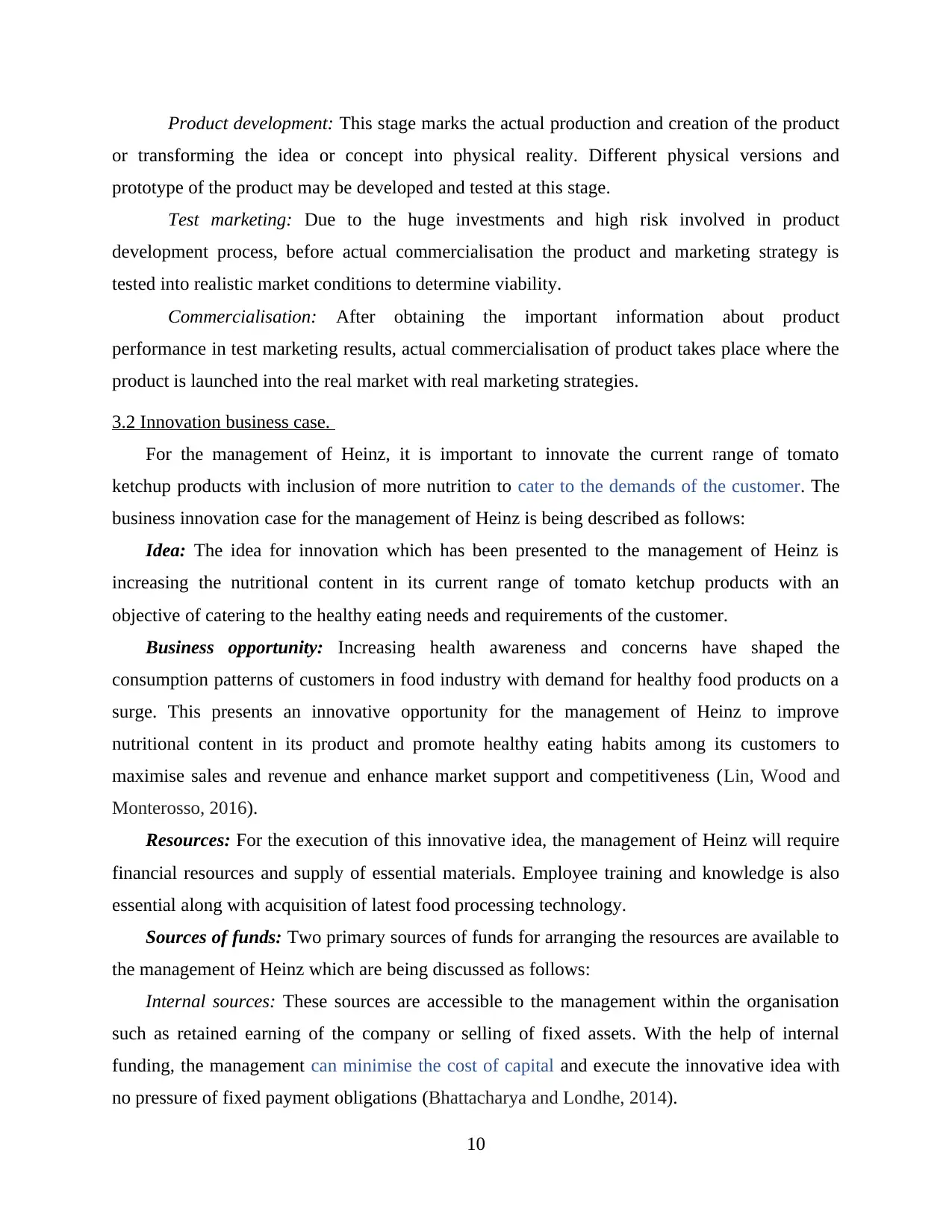
Product development: This stage marks the actual production and creation of the product
or transforming the idea or concept into physical reality. Different physical versions and
prototype of the product may be developed and tested at this stage.
Test marketing: Due to the huge investments and high risk involved in product
development process, before actual commercialisation the product and marketing strategy is
tested into realistic market conditions to determine viability.
Commercialisation: After obtaining the important information about product
performance in test marketing results, actual commercialisation of product takes place where the
product is launched into the real market with real marketing strategies.
3.2 Innovation business case.
For the management of Heinz, it is important to innovate the current range of tomato
ketchup products with inclusion of more nutrition to cater to the demands of the customer. The
business innovation case for the management of Heinz is being described as follows:
Idea: The idea for innovation which has been presented to the management of Heinz is
increasing the nutritional content in its current range of tomato ketchup products with an
objective of catering to the healthy eating needs and requirements of the customer.
Business opportunity: Increasing health awareness and concerns have shaped the
consumption patterns of customers in food industry with demand for healthy food products on a
surge. This presents an innovative opportunity for the management of Heinz to improve
nutritional content in its product and promote healthy eating habits among its customers to
maximise sales and revenue and enhance market support and competitiveness (Lin, Wood and
Monterosso, 2016).
Resources: For the execution of this innovative idea, the management of Heinz will require
financial resources and supply of essential materials. Employee training and knowledge is also
essential along with acquisition of latest food processing technology.
Sources of funds: Two primary sources of funds for arranging the resources are available to
the management of Heinz which are being discussed as follows:
Internal sources: These sources are accessible to the management within the organisation
such as retained earning of the company or selling of fixed assets. With the help of internal
funding, the management can minimise the cost of capital and execute the innovative idea with
no pressure of fixed payment obligations (Bhattacharya and Londhe, 2014).
10
or transforming the idea or concept into physical reality. Different physical versions and
prototype of the product may be developed and tested at this stage.
Test marketing: Due to the huge investments and high risk involved in product
development process, before actual commercialisation the product and marketing strategy is
tested into realistic market conditions to determine viability.
Commercialisation: After obtaining the important information about product
performance in test marketing results, actual commercialisation of product takes place where the
product is launched into the real market with real marketing strategies.
3.2 Innovation business case.
For the management of Heinz, it is important to innovate the current range of tomato
ketchup products with inclusion of more nutrition to cater to the demands of the customer. The
business innovation case for the management of Heinz is being described as follows:
Idea: The idea for innovation which has been presented to the management of Heinz is
increasing the nutritional content in its current range of tomato ketchup products with an
objective of catering to the healthy eating needs and requirements of the customer.
Business opportunity: Increasing health awareness and concerns have shaped the
consumption patterns of customers in food industry with demand for healthy food products on a
surge. This presents an innovative opportunity for the management of Heinz to improve
nutritional content in its product and promote healthy eating habits among its customers to
maximise sales and revenue and enhance market support and competitiveness (Lin, Wood and
Monterosso, 2016).
Resources: For the execution of this innovative idea, the management of Heinz will require
financial resources and supply of essential materials. Employee training and knowledge is also
essential along with acquisition of latest food processing technology.
Sources of funds: Two primary sources of funds for arranging the resources are available to
the management of Heinz which are being discussed as follows:
Internal sources: These sources are accessible to the management within the organisation
such as retained earning of the company or selling of fixed assets. With the help of internal
funding, the management can minimise the cost of capital and execute the innovative idea with
no pressure of fixed payment obligations (Bhattacharya and Londhe, 2014).
10
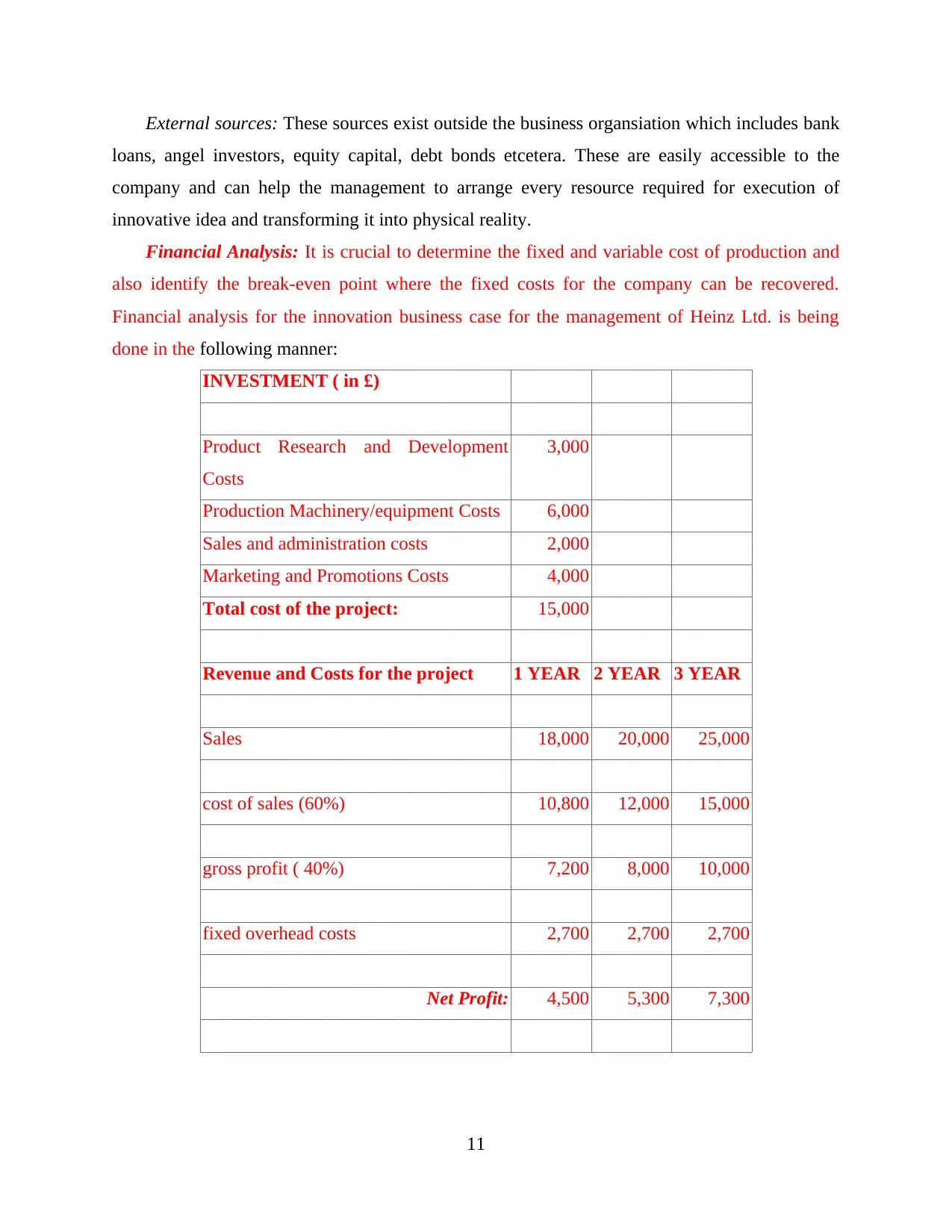
External sources: These sources exist outside the business organsiation which includes bank
loans, angel investors, equity capital, debt bonds etcetera. These are easily accessible to the
company and can help the management to arrange every resource required for execution of
innovative idea and transforming it into physical reality.
Financial Analysis: It is crucial to determine the fixed and variable cost of production and
also identify the break-even point where the fixed costs for the company can be recovered.
Financial analysis for the innovation business case for the management of Heinz Ltd. is being
done in the following manner:
INVESTMENT ( in £)
Product Research and Development
Costs
3,000
Production Machinery/equipment Costs 6,000
Sales and administration costs 2,000
Marketing and Promotions Costs 4,000
Total cost of the project: 15,000
Revenue and Costs for the project 1 YEAR 2 YEAR 3 YEAR
Sales 18,000 20,000 25,000
cost of sales (60%) 10,800 12,000 15,000
gross profit ( 40%) 7,200 8,000 10,000
fixed overhead costs 2,700 2,700 2,700
Net Profit: 4,500 5,300 7,300
11
loans, angel investors, equity capital, debt bonds etcetera. These are easily accessible to the
company and can help the management to arrange every resource required for execution of
innovative idea and transforming it into physical reality.
Financial Analysis: It is crucial to determine the fixed and variable cost of production and
also identify the break-even point where the fixed costs for the company can be recovered.
Financial analysis for the innovation business case for the management of Heinz Ltd. is being
done in the following manner:
INVESTMENT ( in £)
Product Research and Development
Costs
3,000
Production Machinery/equipment Costs 6,000
Sales and administration costs 2,000
Marketing and Promotions Costs 4,000
Total cost of the project: 15,000
Revenue and Costs for the project 1 YEAR 2 YEAR 3 YEAR
Sales 18,000 20,000 25,000
cost of sales (60%) 10,800 12,000 15,000
gross profit ( 40%) 7,200 8,000 10,000
fixed overhead costs 2,700 2,700 2,700
Net Profit: 4,500 5,300 7,300
11
Paraphrase This Document
Need a fresh take? Get an instant paraphrase of this document with our AI Paraphraser
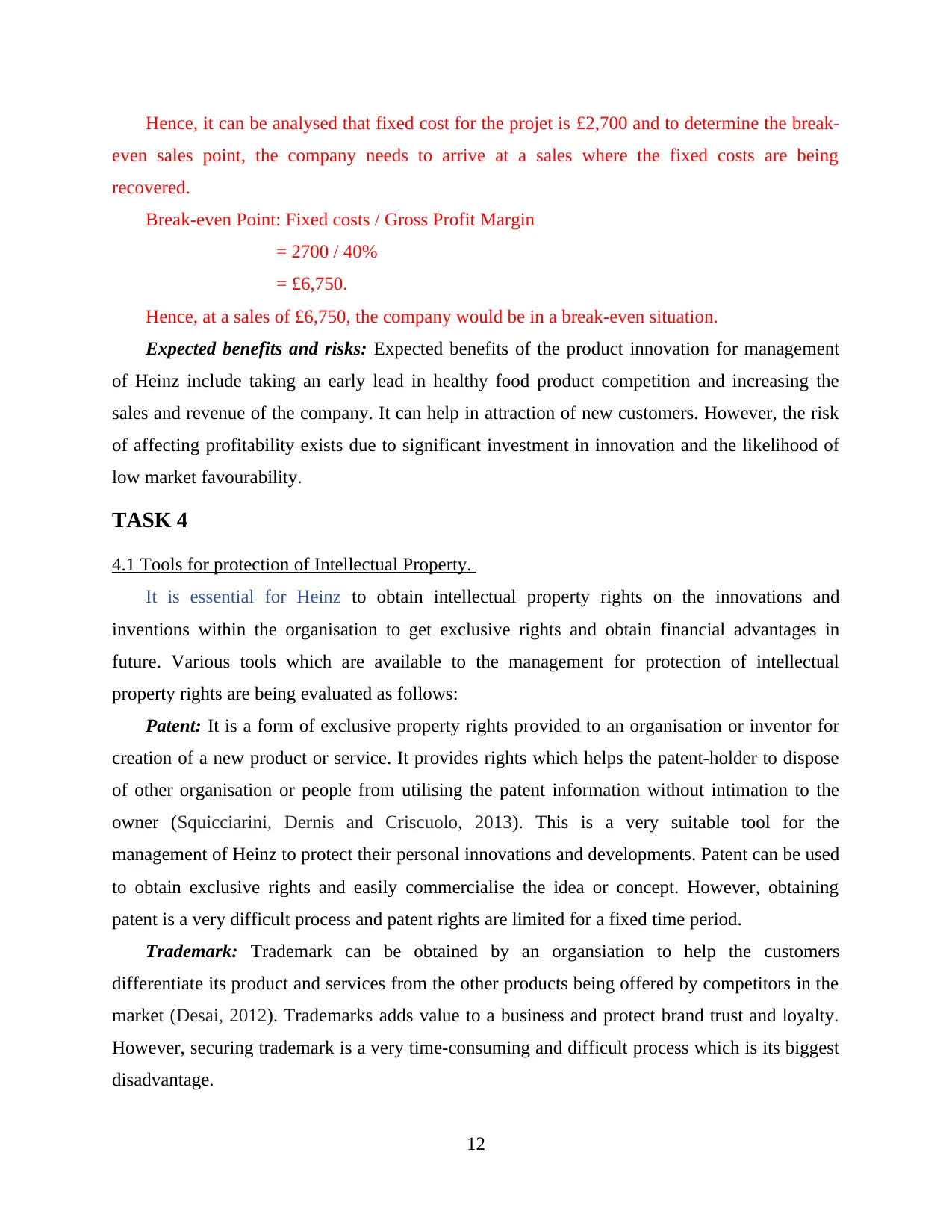
Hence, it can be analysed that fixed cost for the projet is £2,700 and to determine the break-
even sales point, the company needs to arrive at a sales where the fixed costs are being
recovered.
Break-even Point: Fixed costs / Gross Profit Margin
= 2700 / 40%
= £6,750.
Hence, at a sales of £6,750, the company would be in a break-even situation.
Expected benefits and risks: Expected benefits of the product innovation for management
of Heinz include taking an early lead in healthy food product competition and increasing the
sales and revenue of the company. It can help in attraction of new customers. However, the risk
of affecting profitability exists due to significant investment in innovation and the likelihood of
low market favourability.
TASK 4
4.1 Tools for protection of Intellectual Property.
It is essential for Heinz to obtain intellectual property rights on the innovations and
inventions within the organisation to get exclusive rights and obtain financial advantages in
future. Various tools which are available to the management for protection of intellectual
property rights are being evaluated as follows:
Patent: It is a form of exclusive property rights provided to an organisation or inventor for
creation of a new product or service. It provides rights which helps the patent-holder to dispose
of other organisation or people from utilising the patent information without intimation to the
owner (Squicciarini, Dernis and Criscuolo, 2013). This is a very suitable tool for the
management of Heinz to protect their personal innovations and developments. Patent can be used
to obtain exclusive rights and easily commercialise the idea or concept. However, obtaining
patent is a very difficult process and patent rights are limited for a fixed time period.
Trademark: Trademark can be obtained by an organsiation to help the customers
differentiate its product and services from the other products being offered by competitors in the
market (Desai, 2012). Trademarks adds value to a business and protect brand trust and loyalty.
However, securing trademark is a very time-consuming and difficult process which is its biggest
disadvantage.
12
even sales point, the company needs to arrive at a sales where the fixed costs are being
recovered.
Break-even Point: Fixed costs / Gross Profit Margin
= 2700 / 40%
= £6,750.
Hence, at a sales of £6,750, the company would be in a break-even situation.
Expected benefits and risks: Expected benefits of the product innovation for management
of Heinz include taking an early lead in healthy food product competition and increasing the
sales and revenue of the company. It can help in attraction of new customers. However, the risk
of affecting profitability exists due to significant investment in innovation and the likelihood of
low market favourability.
TASK 4
4.1 Tools for protection of Intellectual Property.
It is essential for Heinz to obtain intellectual property rights on the innovations and
inventions within the organisation to get exclusive rights and obtain financial advantages in
future. Various tools which are available to the management for protection of intellectual
property rights are being evaluated as follows:
Patent: It is a form of exclusive property rights provided to an organisation or inventor for
creation of a new product or service. It provides rights which helps the patent-holder to dispose
of other organisation or people from utilising the patent information without intimation to the
owner (Squicciarini, Dernis and Criscuolo, 2013). This is a very suitable tool for the
management of Heinz to protect their personal innovations and developments. Patent can be used
to obtain exclusive rights and easily commercialise the idea or concept. However, obtaining
patent is a very difficult process and patent rights are limited for a fixed time period.
Trademark: Trademark can be obtained by an organsiation to help the customers
differentiate its product and services from the other products being offered by competitors in the
market (Desai, 2012). Trademarks adds value to a business and protect brand trust and loyalty.
However, securing trademark is a very time-consuming and difficult process which is its biggest
disadvantage.
12
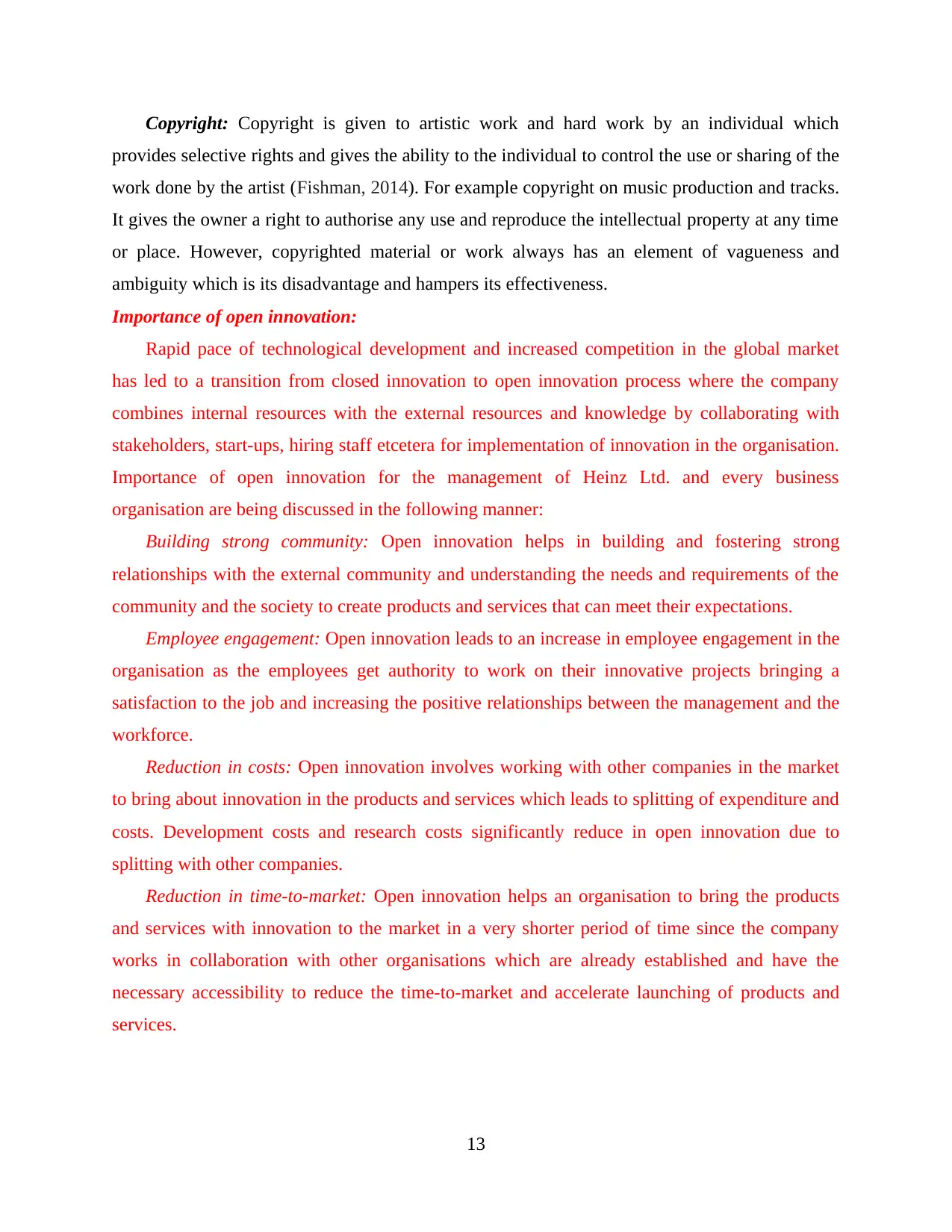
Copyright: Copyright is given to artistic work and hard work by an individual which
provides selective rights and gives the ability to the individual to control the use or sharing of the
work done by the artist (Fishman, 2014). For example copyright on music production and tracks.
It gives the owner a right to authorise any use and reproduce the intellectual property at any time
or place. However, copyrighted material or work always has an element of vagueness and
ambiguity which is its disadvantage and hampers its effectiveness.
Importance of open innovation:
Rapid pace of technological development and increased competition in the global market
has led to a transition from closed innovation to open innovation process where the company
combines internal resources with the external resources and knowledge by collaborating with
stakeholders, start-ups, hiring staff etcetera for implementation of innovation in the organisation.
Importance of open innovation for the management of Heinz Ltd. and every business
organisation are being discussed in the following manner:
Building strong community: Open innovation helps in building and fostering strong
relationships with the external community and understanding the needs and requirements of the
community and the society to create products and services that can meet their expectations.
Employee engagement: Open innovation leads to an increase in employee engagement in the
organisation as the employees get authority to work on their innovative projects bringing a
satisfaction to the job and increasing the positive relationships between the management and the
workforce.
Reduction in costs: Open innovation involves working with other companies in the market
to bring about innovation in the products and services which leads to splitting of expenditure and
costs. Development costs and research costs significantly reduce in open innovation due to
splitting with other companies.
Reduction in time-to-market: Open innovation helps an organisation to bring the products
and services with innovation to the market in a very shorter period of time since the company
works in collaboration with other organisations which are already established and have the
necessary accessibility to reduce the time-to-market and accelerate launching of products and
services.
13
provides selective rights and gives the ability to the individual to control the use or sharing of the
work done by the artist (Fishman, 2014). For example copyright on music production and tracks.
It gives the owner a right to authorise any use and reproduce the intellectual property at any time
or place. However, copyrighted material or work always has an element of vagueness and
ambiguity which is its disadvantage and hampers its effectiveness.
Importance of open innovation:
Rapid pace of technological development and increased competition in the global market
has led to a transition from closed innovation to open innovation process where the company
combines internal resources with the external resources and knowledge by collaborating with
stakeholders, start-ups, hiring staff etcetera for implementation of innovation in the organisation.
Importance of open innovation for the management of Heinz Ltd. and every business
organisation are being discussed in the following manner:
Building strong community: Open innovation helps in building and fostering strong
relationships with the external community and understanding the needs and requirements of the
community and the society to create products and services that can meet their expectations.
Employee engagement: Open innovation leads to an increase in employee engagement in the
organisation as the employees get authority to work on their innovative projects bringing a
satisfaction to the job and increasing the positive relationships between the management and the
workforce.
Reduction in costs: Open innovation involves working with other companies in the market
to bring about innovation in the products and services which leads to splitting of expenditure and
costs. Development costs and research costs significantly reduce in open innovation due to
splitting with other companies.
Reduction in time-to-market: Open innovation helps an organisation to bring the products
and services with innovation to the market in a very shorter period of time since the company
works in collaboration with other organisations which are already established and have the
necessary accessibility to reduce the time-to-market and accelerate launching of products and
services.
13
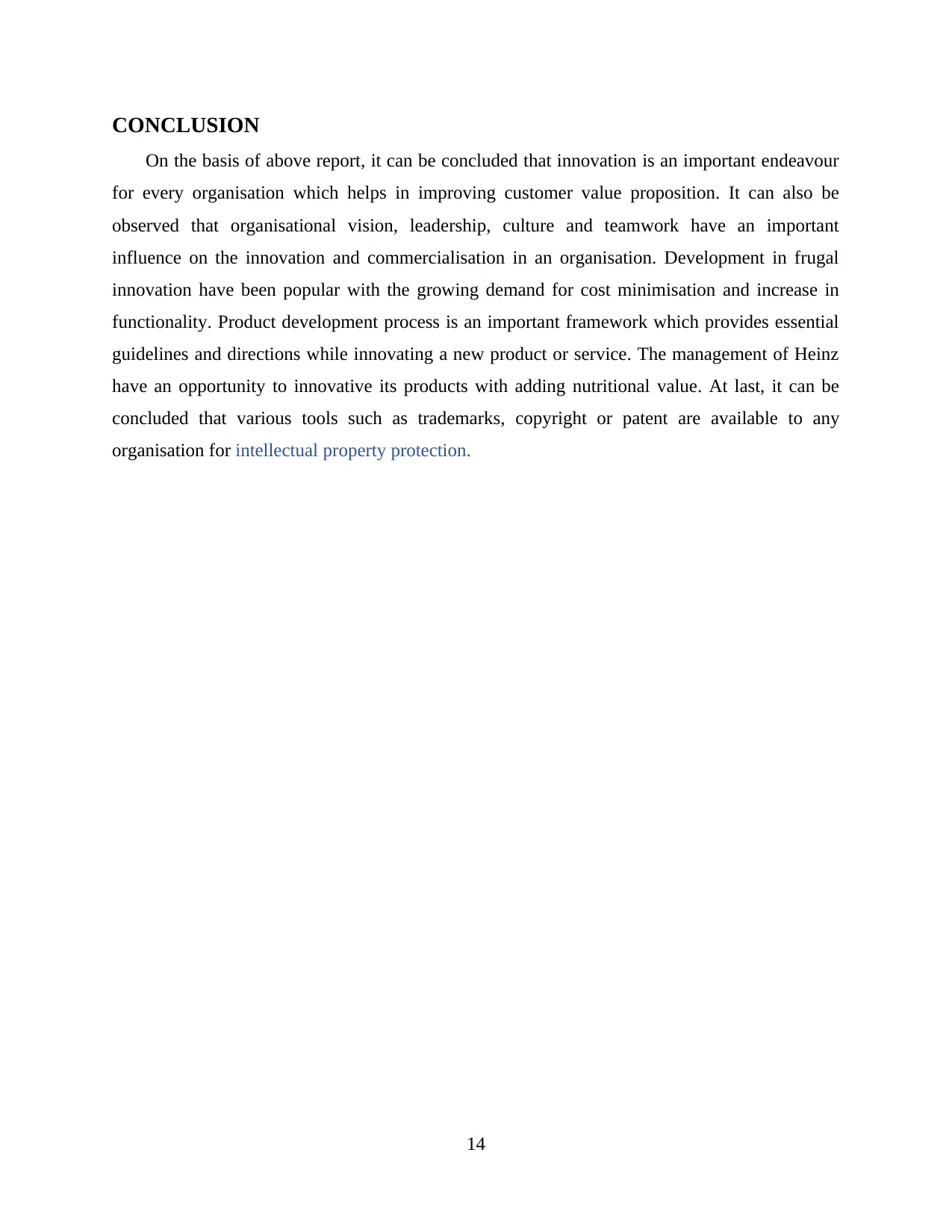
CONCLUSION
On the basis of above report, it can be concluded that innovation is an important endeavour
for every organisation which helps in improving customer value proposition. It can also be
observed that organisational vision, leadership, culture and teamwork have an important
influence on the innovation and commercialisation in an organisation. Development in frugal
innovation have been popular with the growing demand for cost minimisation and increase in
functionality. Product development process is an important framework which provides essential
guidelines and directions while innovating a new product or service. The management of Heinz
have an opportunity to innovative its products with adding nutritional value. At last, it can be
concluded that various tools such as trademarks, copyright or patent are available to any
organisation for intellectual property protection.
14
On the basis of above report, it can be concluded that innovation is an important endeavour
for every organisation which helps in improving customer value proposition. It can also be
observed that organisational vision, leadership, culture and teamwork have an important
influence on the innovation and commercialisation in an organisation. Development in frugal
innovation have been popular with the growing demand for cost minimisation and increase in
functionality. Product development process is an important framework which provides essential
guidelines and directions while innovating a new product or service. The management of Heinz
have an opportunity to innovative its products with adding nutritional value. At last, it can be
concluded that various tools such as trademarks, copyright or patent are available to any
organisation for intellectual property protection.
14
Secure Best Marks with AI Grader
Need help grading? Try our AI Grader for instant feedback on your assignments.
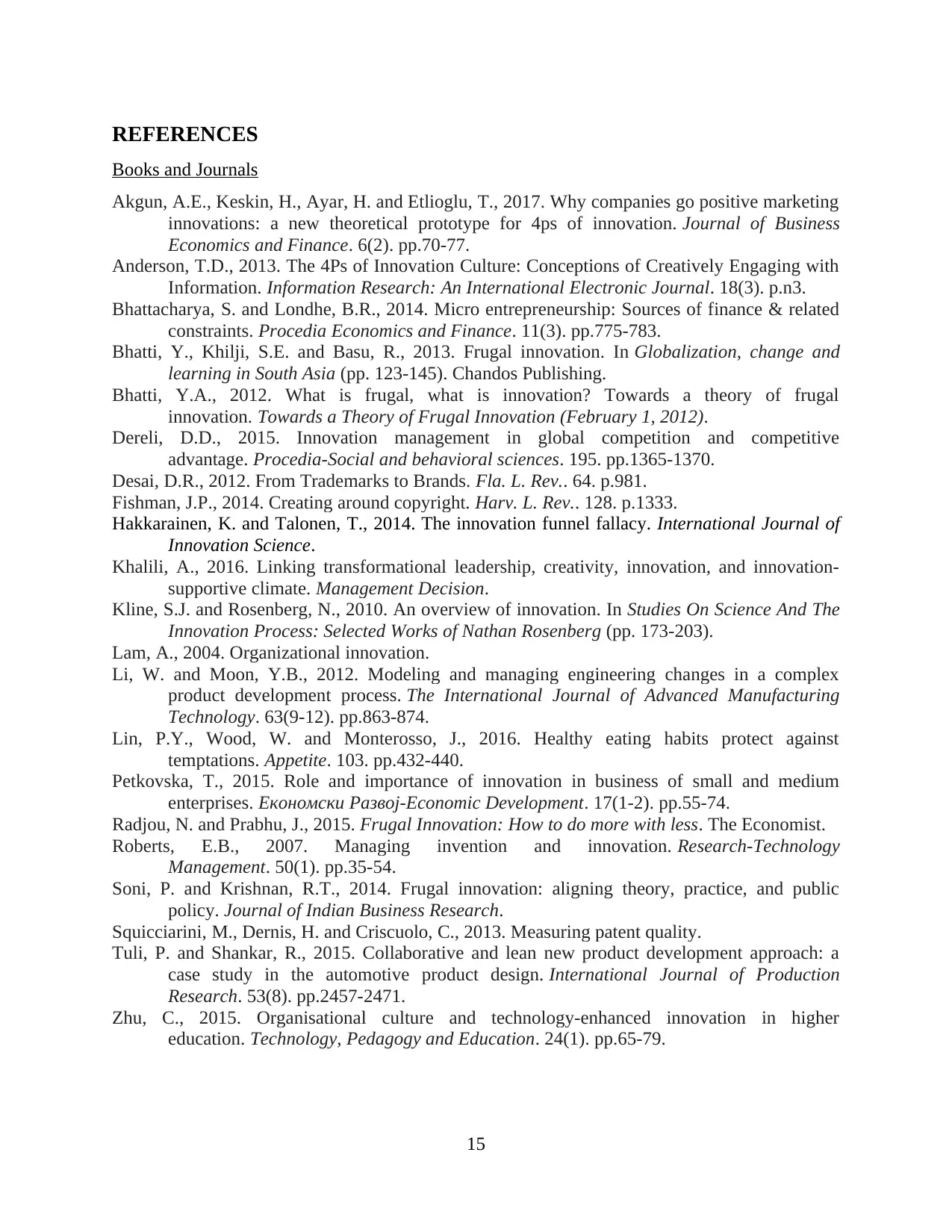
REFERENCES
Books and Journals
Akgun, A.E., Keskin, H., Ayar, H. and Etlioglu, T., 2017. Why companies go positive marketing
innovations: a new theoretical prototype for 4ps of innovation. Journal of Business
Economics and Finance. 6(2). pp.70-77.
Anderson, T.D., 2013. The 4Ps of Innovation Culture: Conceptions of Creatively Engaging with
Information. Information Research: An International Electronic Journal. 18(3). p.n3.
Bhattacharya, S. and Londhe, B.R., 2014. Micro entrepreneurship: Sources of finance & related
constraints. Procedia Economics and Finance. 11(3). pp.775-783.
Bhatti, Y., Khilji, S.E. and Basu, R., 2013. Frugal innovation. In Globalization, change and
learning in South Asia (pp. 123-145). Chandos Publishing.
Bhatti, Y.A., 2012. What is frugal, what is innovation? Towards a theory of frugal
innovation. Towards a Theory of Frugal Innovation (February 1, 2012).
Dereli, D.D., 2015. Innovation management in global competition and competitive
advantage. Procedia-Social and behavioral sciences. 195. pp.1365-1370.
Desai, D.R., 2012. From Trademarks to Brands. Fla. L. Rev.. 64. p.981.
Fishman, J.P., 2014. Creating around copyright. Harv. L. Rev.. 128. p.1333.
Hakkarainen, K. and Talonen, T., 2014. The innovation funnel fallacy. International Journal of
Innovation Science.
Khalili, A., 2016. Linking transformational leadership, creativity, innovation, and innovation-
supportive climate. Management Decision.
Kline, S.J. and Rosenberg, N., 2010. An overview of innovation. In Studies On Science And The
Innovation Process: Selected Works of Nathan Rosenberg (pp. 173-203).
Lam, A., 2004. Organizational innovation.
Li, W. and Moon, Y.B., 2012. Modeling and managing engineering changes in a complex
product development process. The International Journal of Advanced Manufacturing
Technology. 63(9-12). pp.863-874.
Lin, P.Y., Wood, W. and Monterosso, J., 2016. Healthy eating habits protect against
temptations. Appetite. 103. pp.432-440.
Petkovska, T., 2015. Role and importance of innovation in business of small and medium
enterprises. Економски Развој-Economic Development. 17(1-2). pp.55-74.
Radjou, N. and Prabhu, J., 2015. Frugal Innovation: How to do more with less. The Economist.
Roberts, E.B., 2007. Managing invention and innovation. Research-Technology
Management. 50(1). pp.35-54.
Soni, P. and Krishnan, R.T., 2014. Frugal innovation: aligning theory, practice, and public
policy. Journal of Indian Business Research.
Squicciarini, M., Dernis, H. and Criscuolo, C., 2013. Measuring patent quality.
Tuli, P. and Shankar, R., 2015. Collaborative and lean new product development approach: a
case study in the automotive product design. International Journal of Production
Research. 53(8). pp.2457-2471.
Zhu, C., 2015. Organisational culture and technology-enhanced innovation in higher
education. Technology, Pedagogy and Education. 24(1). pp.65-79.
15
Books and Journals
Akgun, A.E., Keskin, H., Ayar, H. and Etlioglu, T., 2017. Why companies go positive marketing
innovations: a new theoretical prototype for 4ps of innovation. Journal of Business
Economics and Finance. 6(2). pp.70-77.
Anderson, T.D., 2013. The 4Ps of Innovation Culture: Conceptions of Creatively Engaging with
Information. Information Research: An International Electronic Journal. 18(3). p.n3.
Bhattacharya, S. and Londhe, B.R., 2014. Micro entrepreneurship: Sources of finance & related
constraints. Procedia Economics and Finance. 11(3). pp.775-783.
Bhatti, Y., Khilji, S.E. and Basu, R., 2013. Frugal innovation. In Globalization, change and
learning in South Asia (pp. 123-145). Chandos Publishing.
Bhatti, Y.A., 2012. What is frugal, what is innovation? Towards a theory of frugal
innovation. Towards a Theory of Frugal Innovation (February 1, 2012).
Dereli, D.D., 2015. Innovation management in global competition and competitive
advantage. Procedia-Social and behavioral sciences. 195. pp.1365-1370.
Desai, D.R., 2012. From Trademarks to Brands. Fla. L. Rev.. 64. p.981.
Fishman, J.P., 2014. Creating around copyright. Harv. L. Rev.. 128. p.1333.
Hakkarainen, K. and Talonen, T., 2014. The innovation funnel fallacy. International Journal of
Innovation Science.
Khalili, A., 2016. Linking transformational leadership, creativity, innovation, and innovation-
supportive climate. Management Decision.
Kline, S.J. and Rosenberg, N., 2010. An overview of innovation. In Studies On Science And The
Innovation Process: Selected Works of Nathan Rosenberg (pp. 173-203).
Lam, A., 2004. Organizational innovation.
Li, W. and Moon, Y.B., 2012. Modeling and managing engineering changes in a complex
product development process. The International Journal of Advanced Manufacturing
Technology. 63(9-12). pp.863-874.
Lin, P.Y., Wood, W. and Monterosso, J., 2016. Healthy eating habits protect against
temptations. Appetite. 103. pp.432-440.
Petkovska, T., 2015. Role and importance of innovation in business of small and medium
enterprises. Економски Развој-Economic Development. 17(1-2). pp.55-74.
Radjou, N. and Prabhu, J., 2015. Frugal Innovation: How to do more with less. The Economist.
Roberts, E.B., 2007. Managing invention and innovation. Research-Technology
Management. 50(1). pp.35-54.
Soni, P. and Krishnan, R.T., 2014. Frugal innovation: aligning theory, practice, and public
policy. Journal of Indian Business Research.
Squicciarini, M., Dernis, H. and Criscuolo, C., 2013. Measuring patent quality.
Tuli, P. and Shankar, R., 2015. Collaborative and lean new product development approach: a
case study in the automotive product design. International Journal of Production
Research. 53(8). pp.2457-2471.
Zhu, C., 2015. Organisational culture and technology-enhanced innovation in higher
education. Technology, Pedagogy and Education. 24(1). pp.65-79.
15

16
1 out of 18
Related Documents
Your All-in-One AI-Powered Toolkit for Academic Success.
+13062052269
info@desklib.com
Available 24*7 on WhatsApp / Email
![[object Object]](/_next/static/media/star-bottom.7253800d.svg)
Unlock your academic potential
© 2024 | Zucol Services PVT LTD | All rights reserved.





